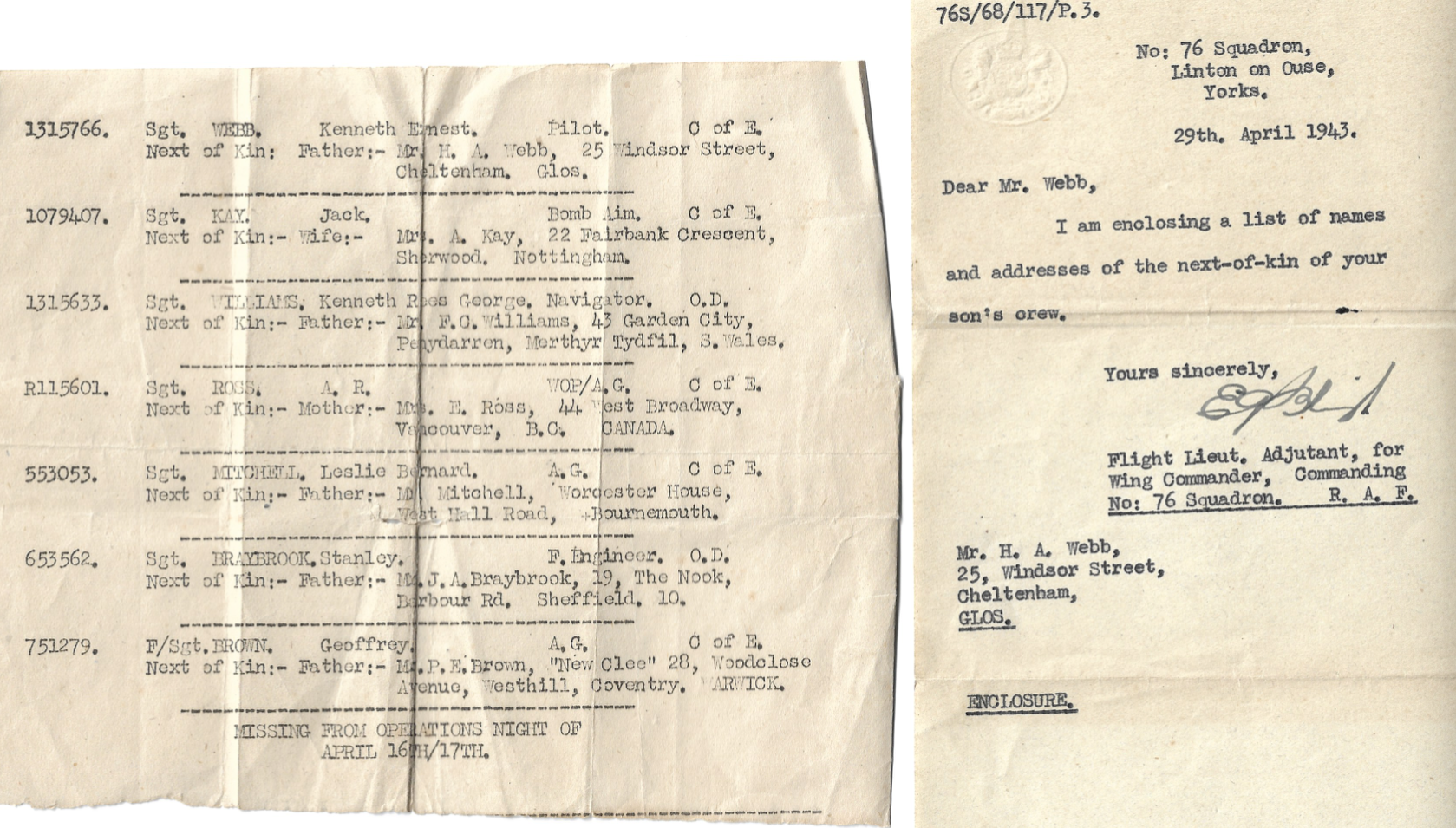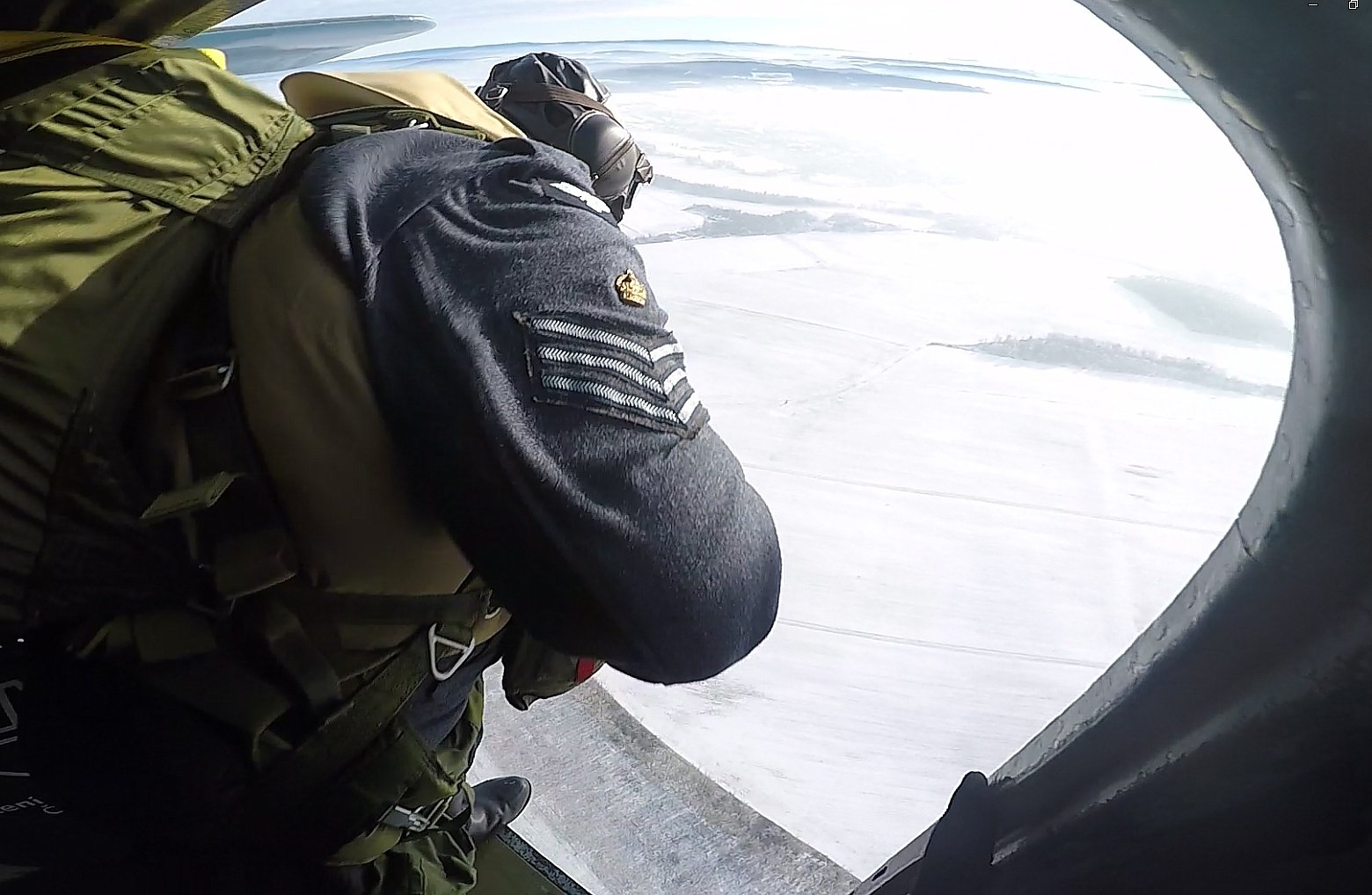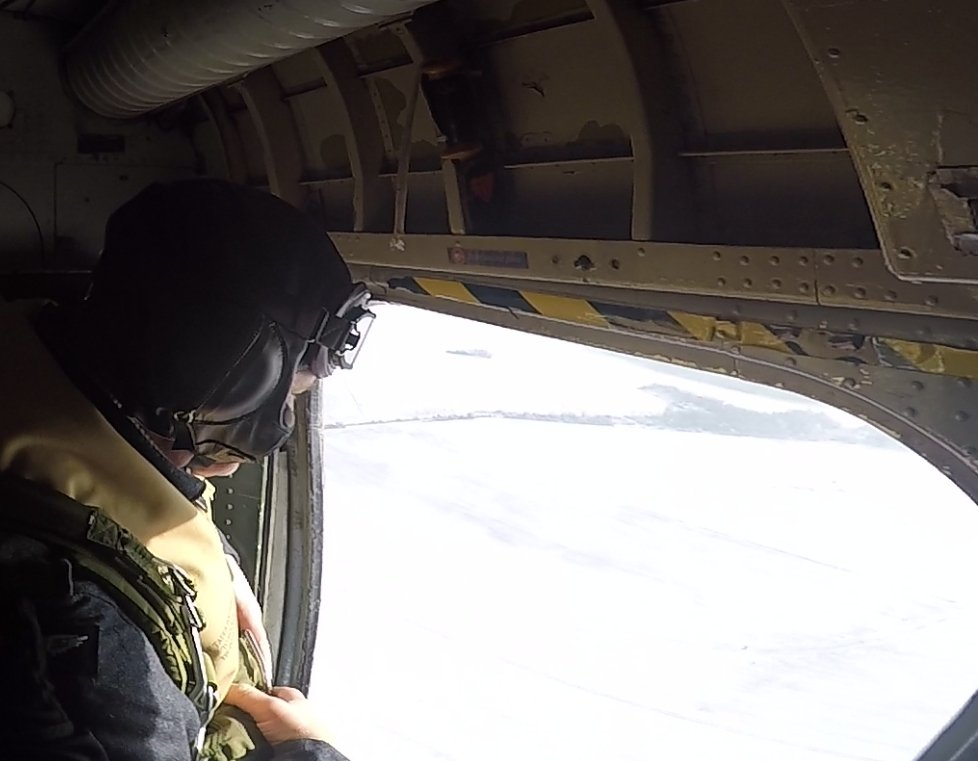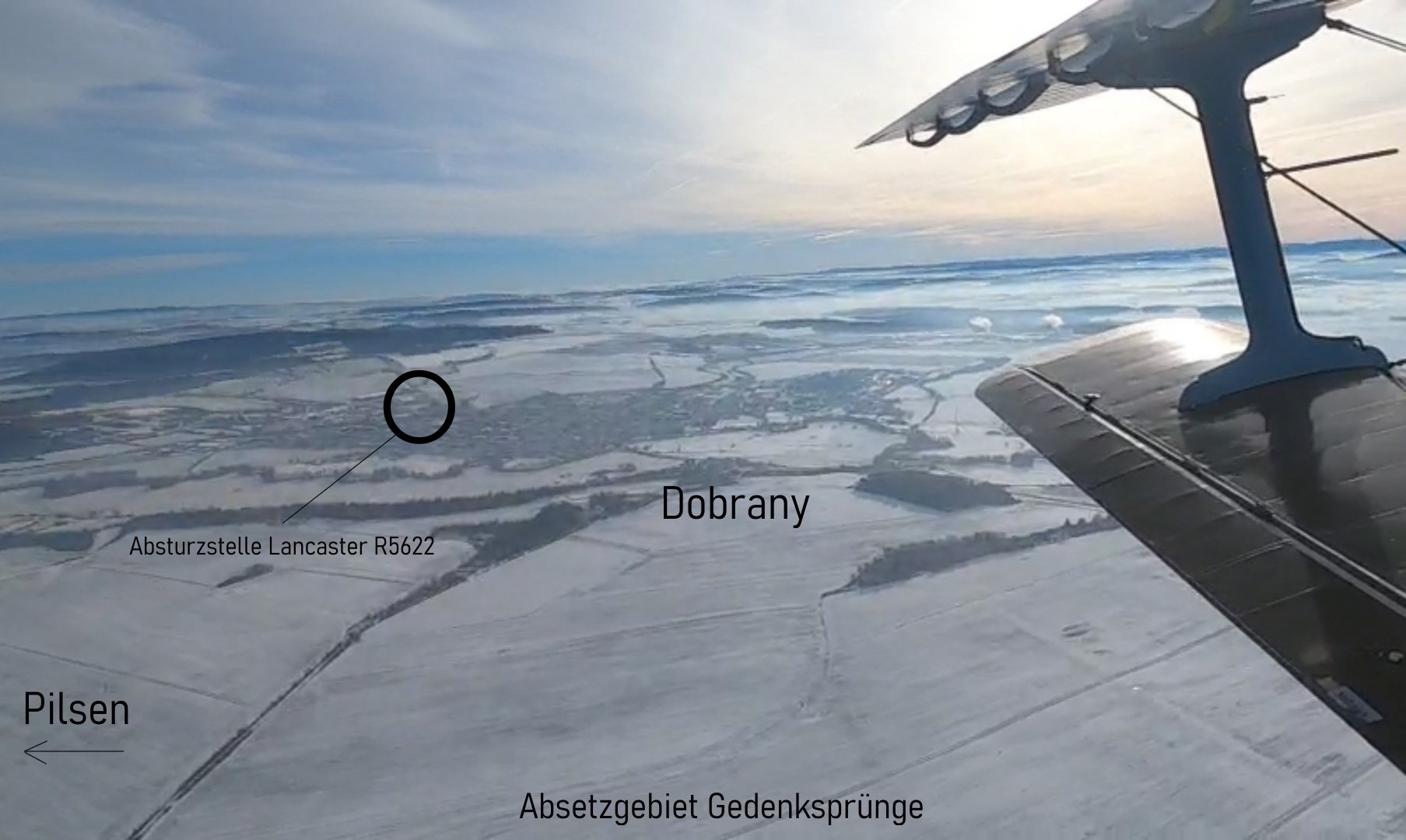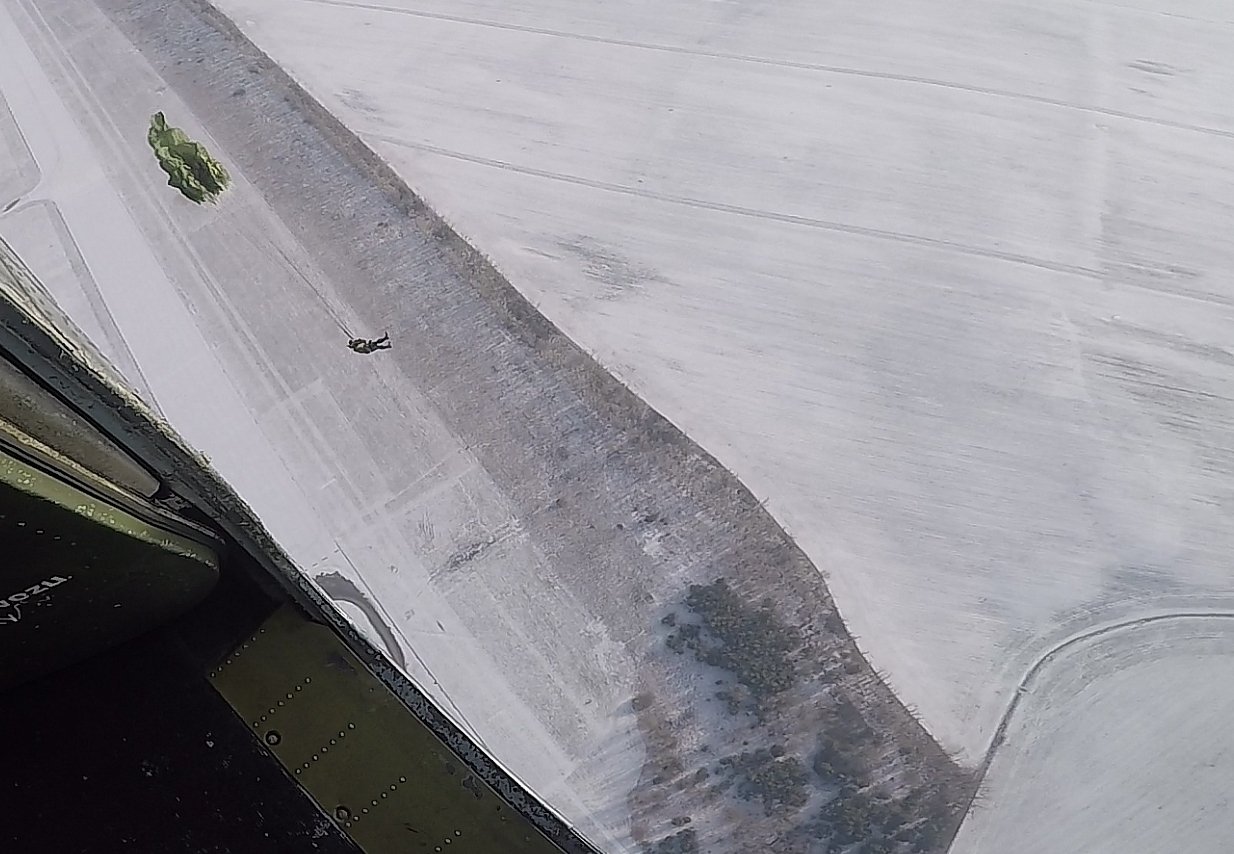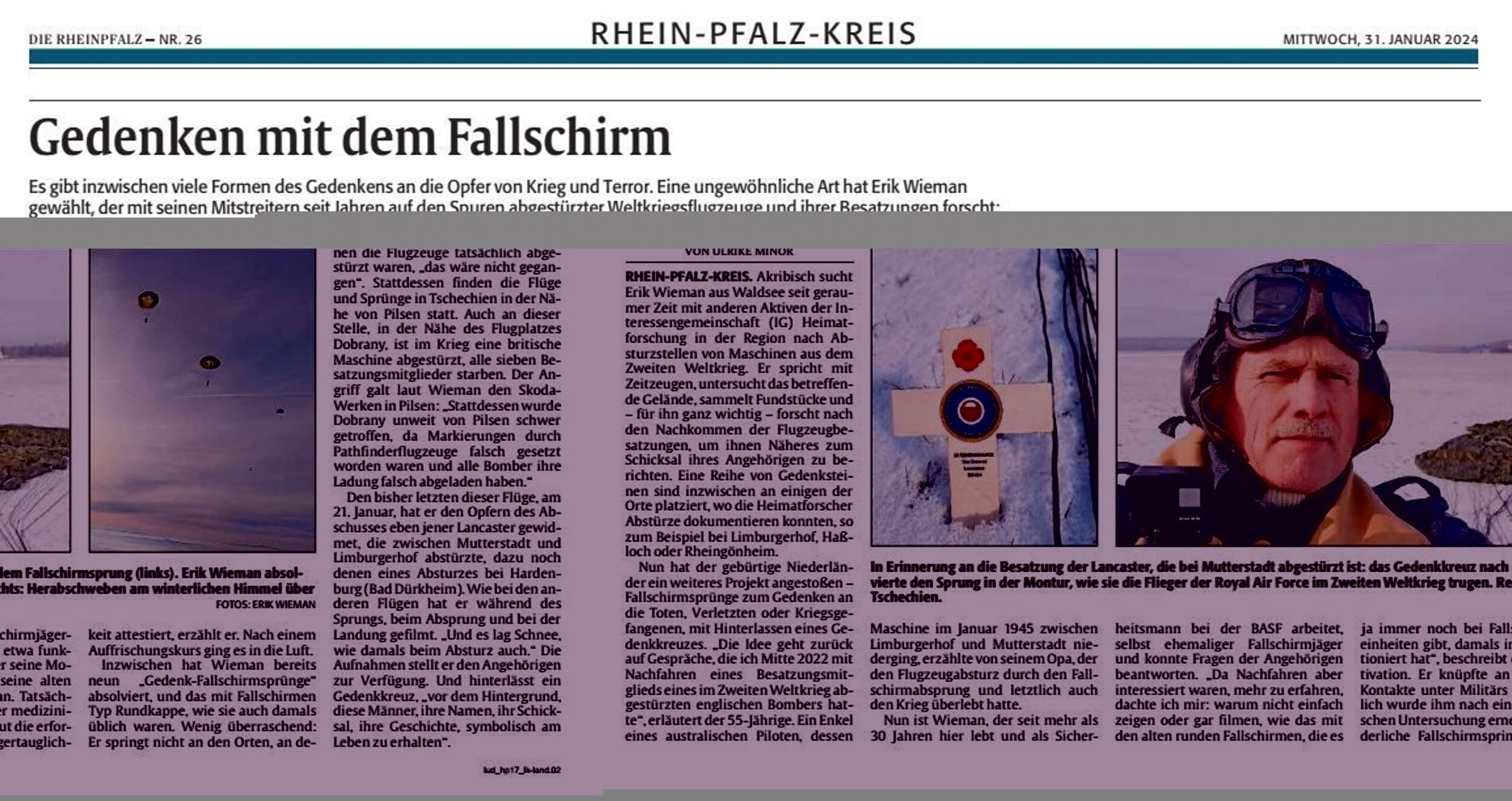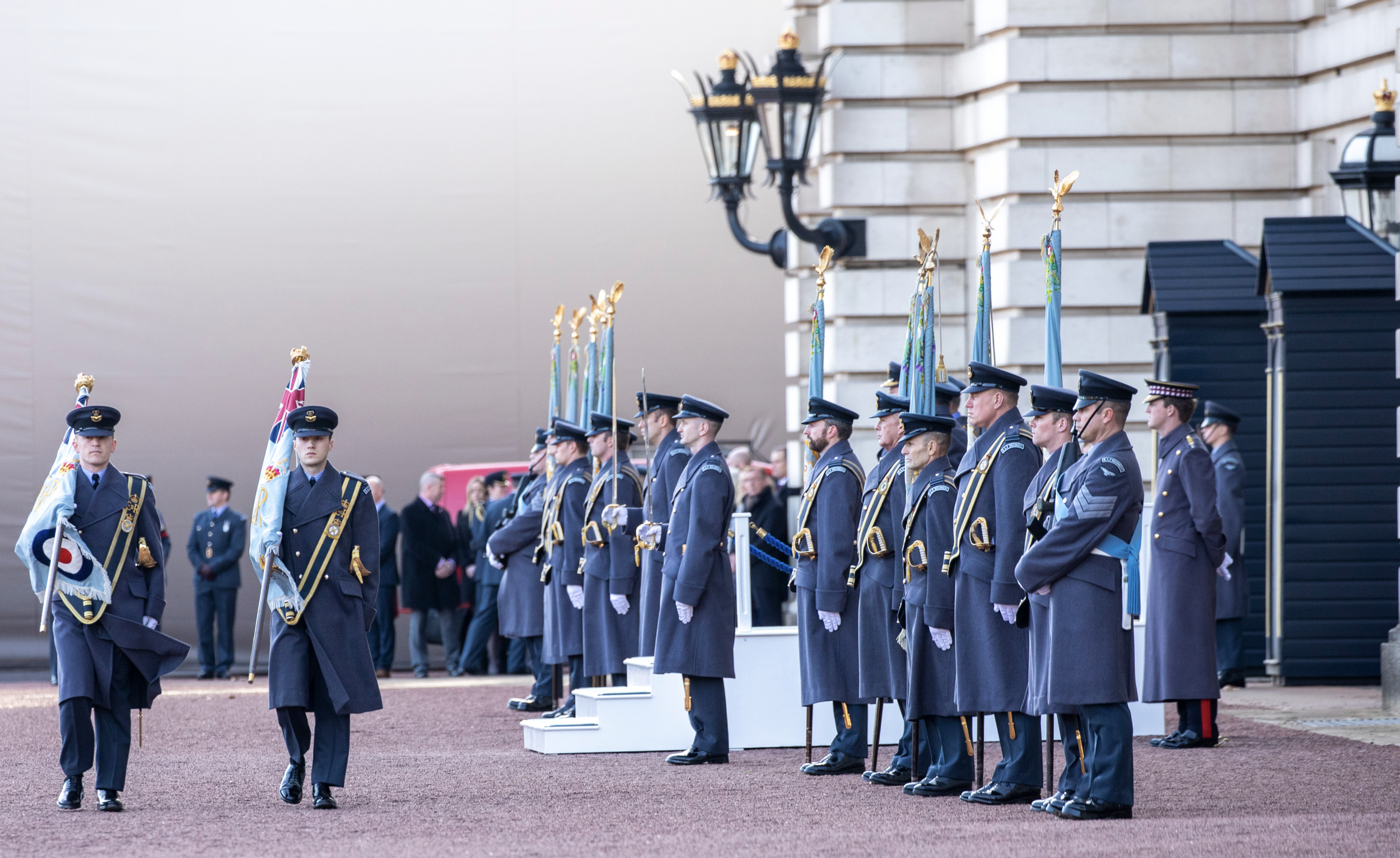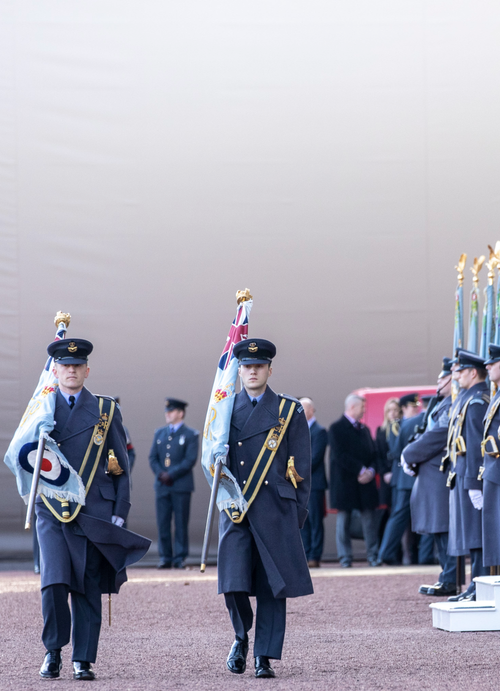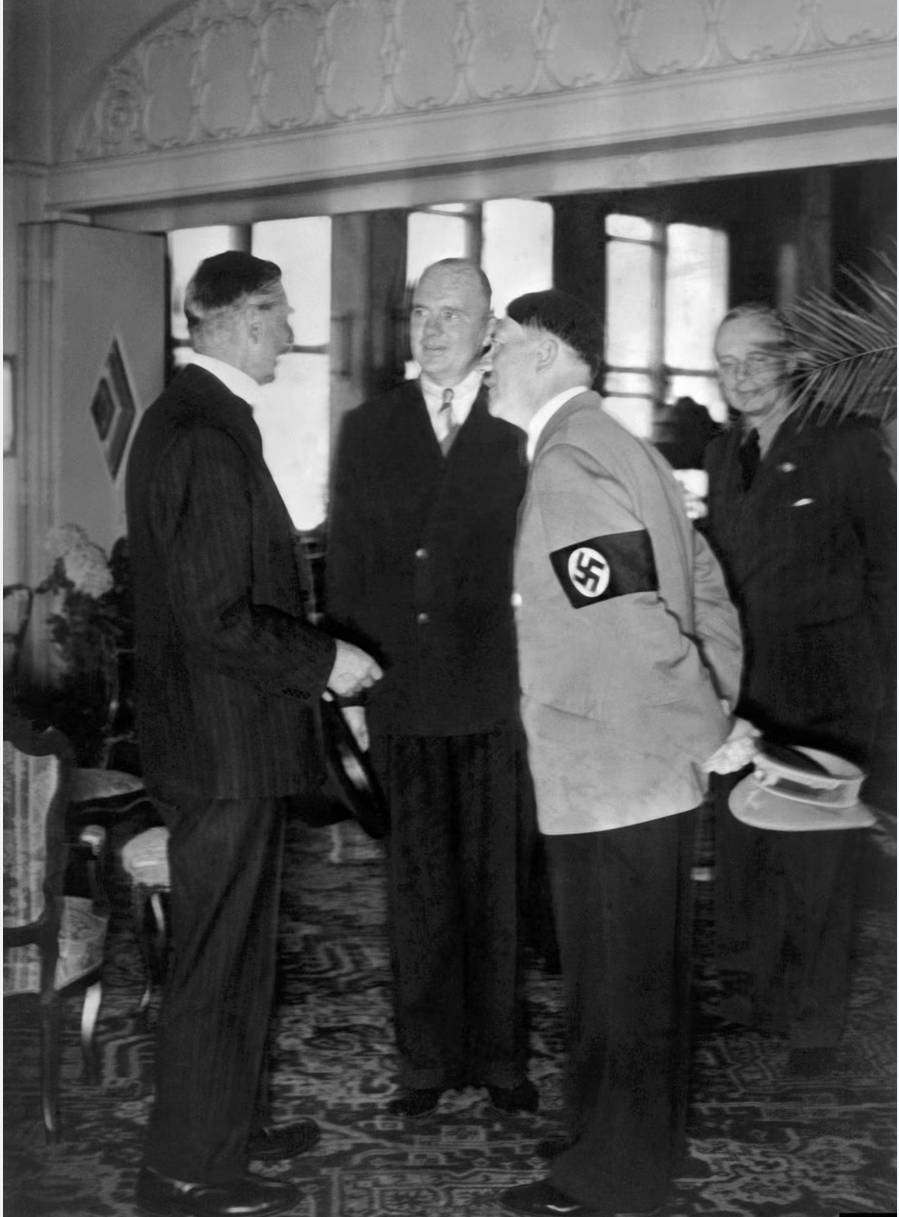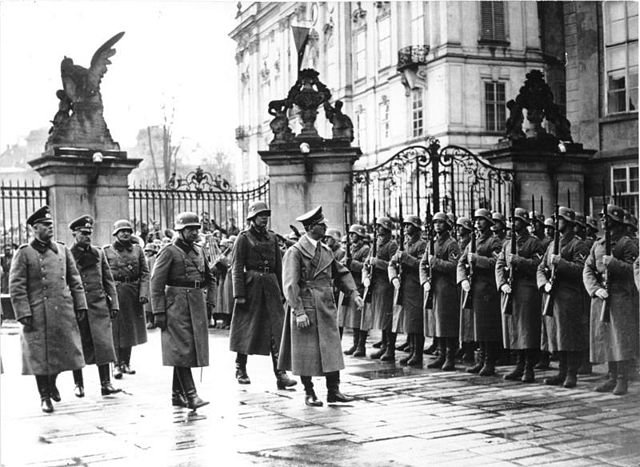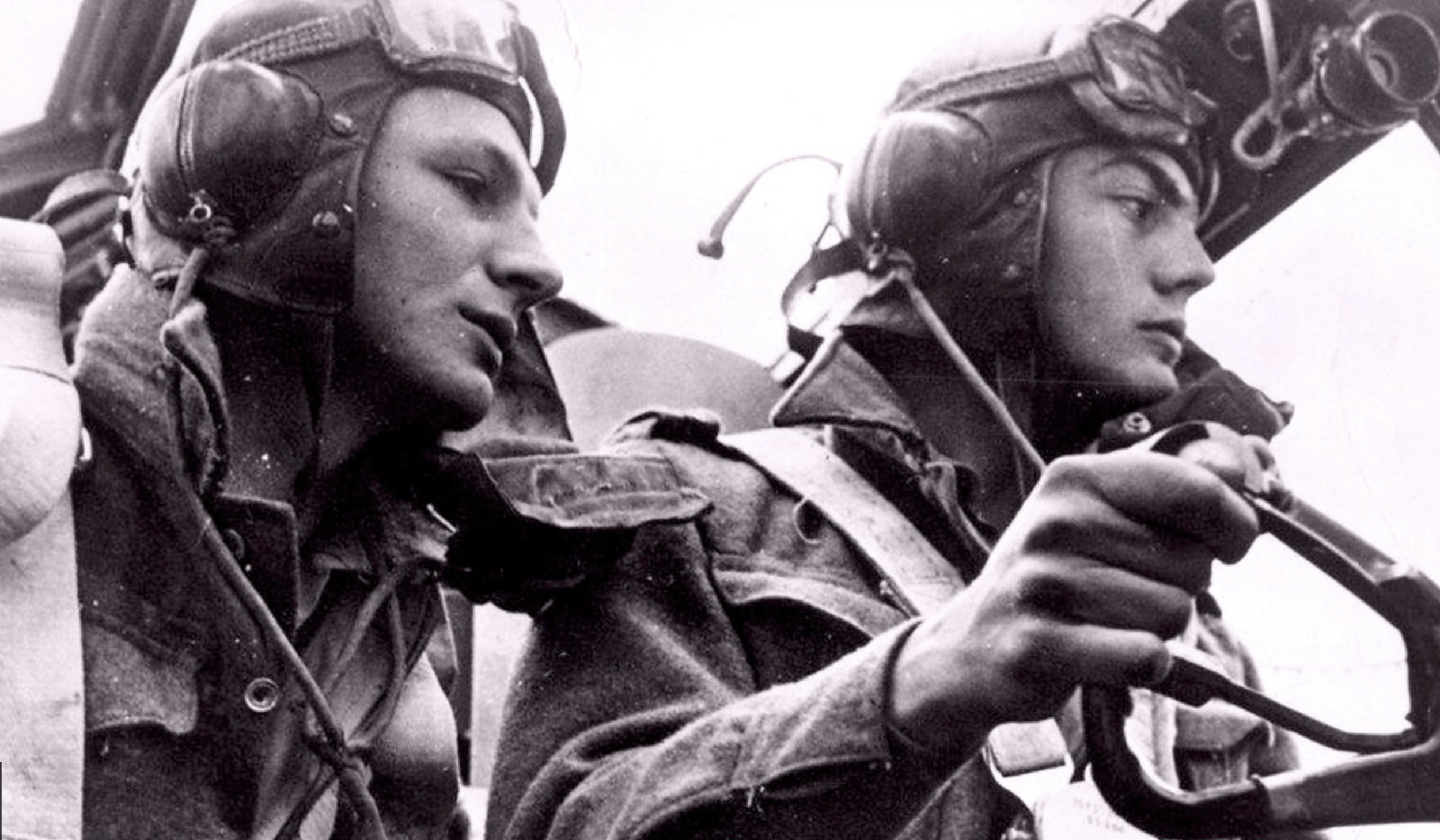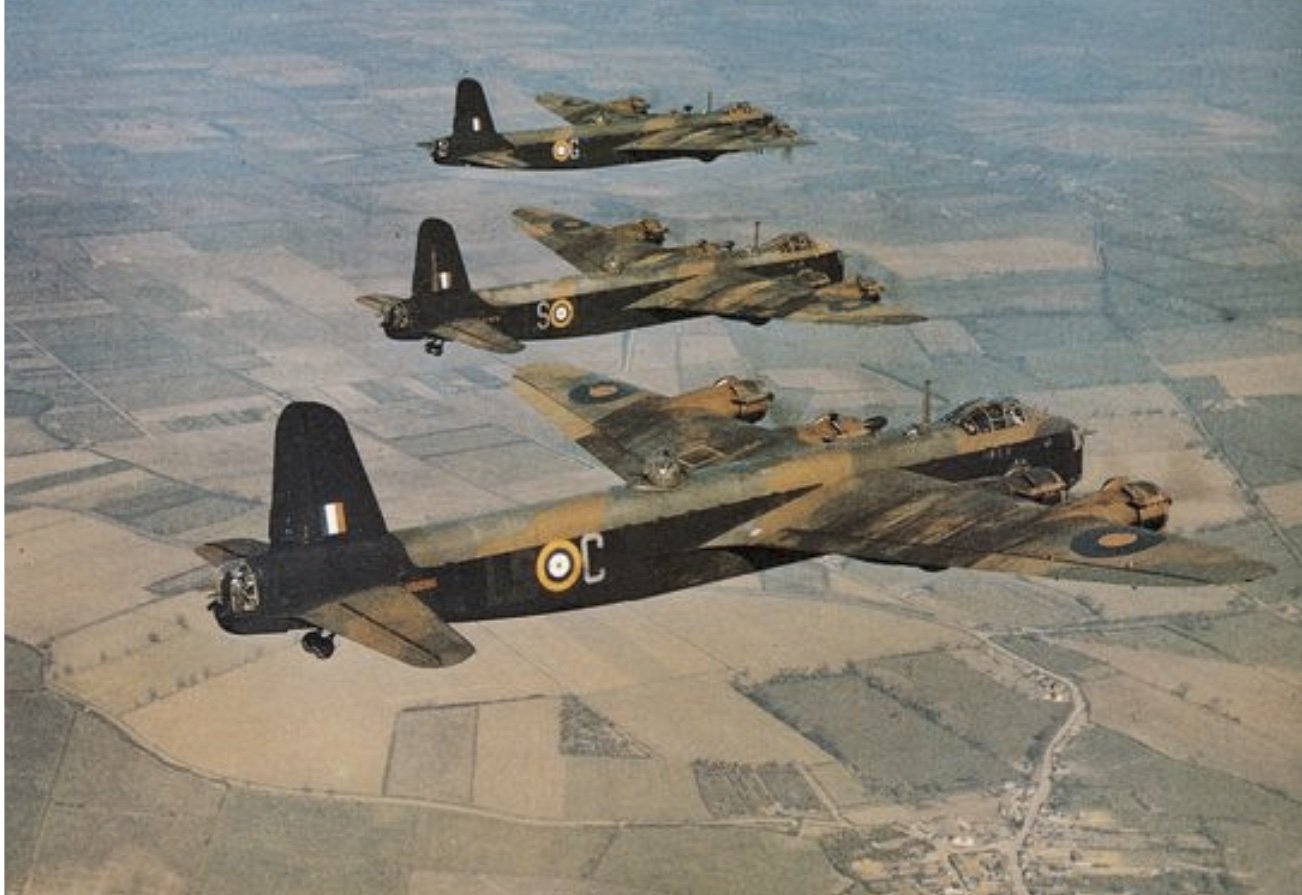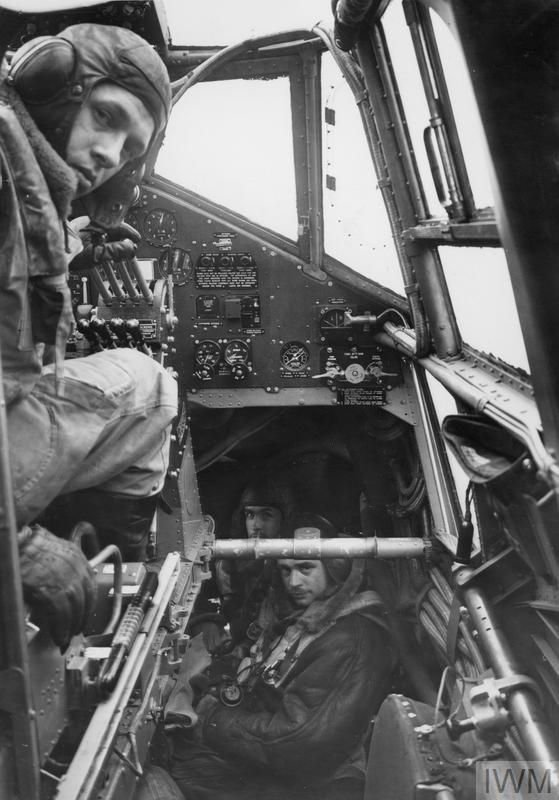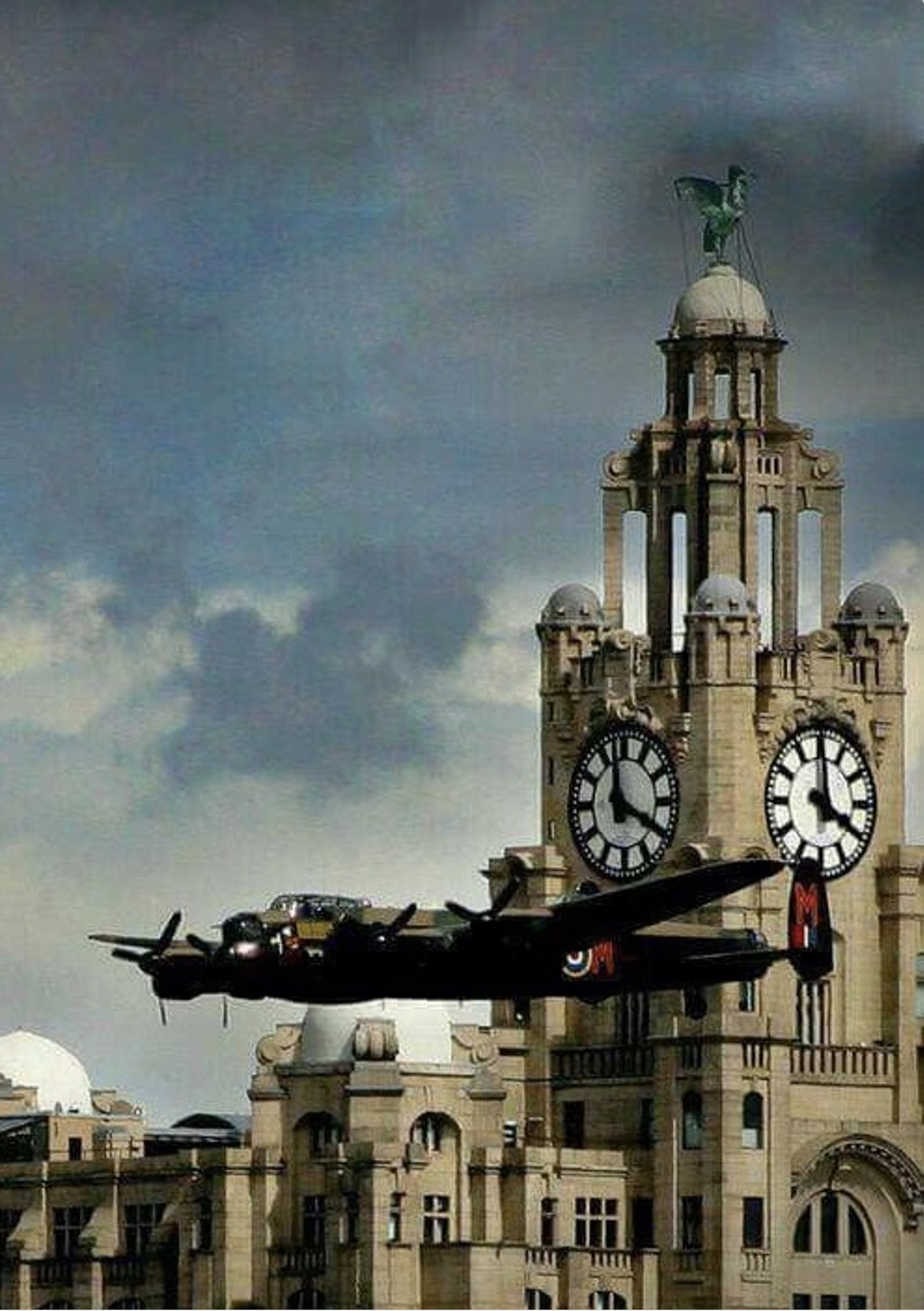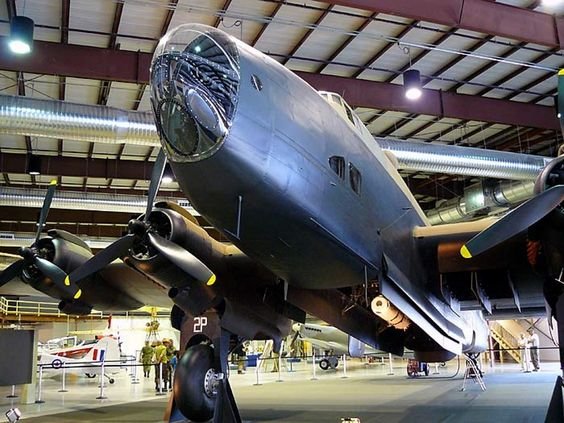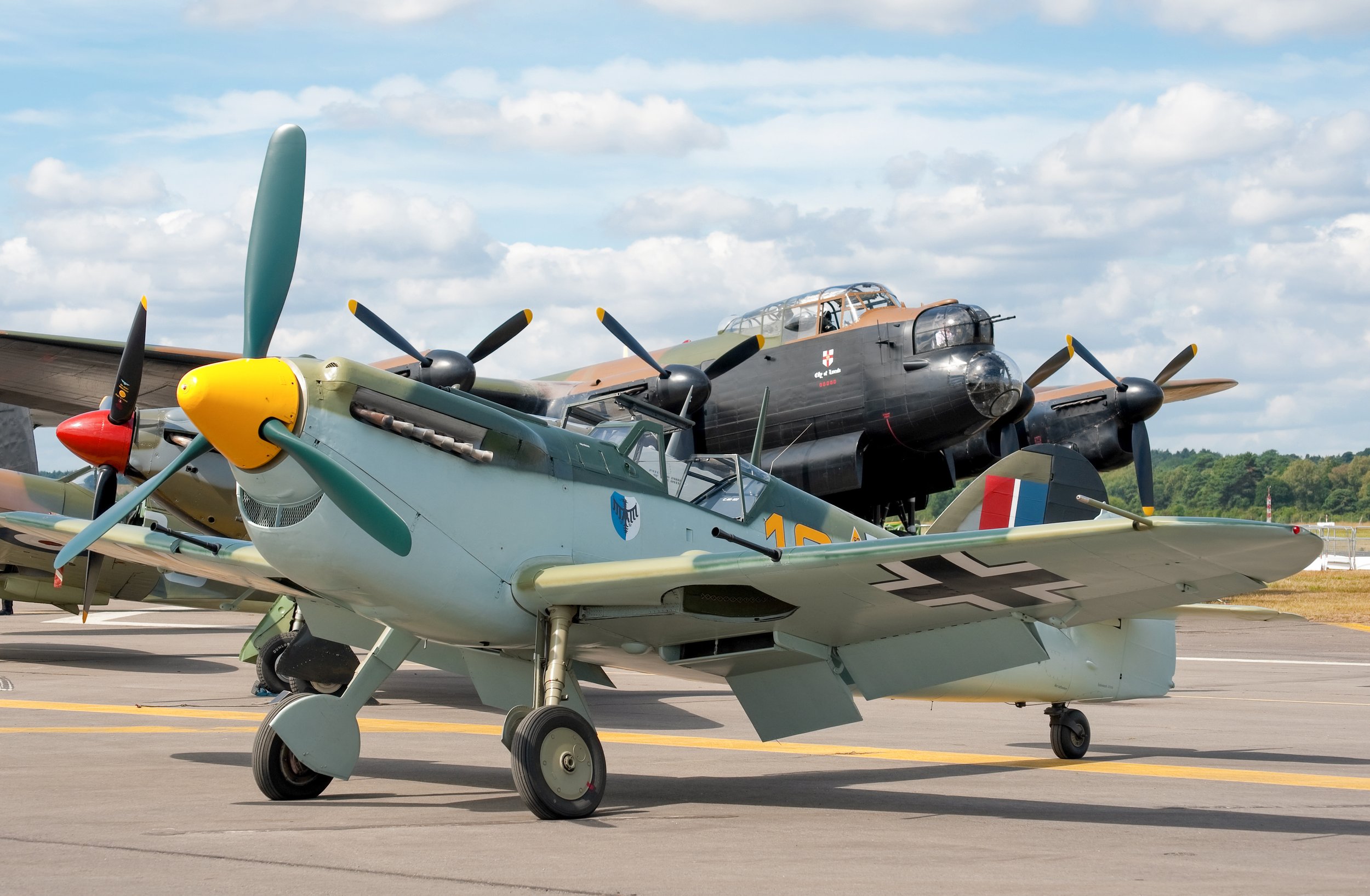RAF 38: ‘And Fifty Nine of Our Aircraft Have Failed to Return’
76 Squadron
R.A.F. Linton-on-Ouse
16-17 April 1943
Operation Frothblower
and
Operation Chubb
Chapter One
I
On 16 April 1943, Royal Air Force Bomber Command carried out the longest raid of the Second World War up until that point on history’s timeline, assembling two forces of four engine heavy bombers and twin engine medium bombers, assembled over the skies of Lincolnshire and Yorkshire, England, from 31 RAF Stations in twelve Counties.
The principal target was the Škoda Armaments Works in the city of Pilsen (Plzeň) in occupied Czechoslovakia (Czechia, today). Following occupation by Nazi Germany in 1939, Škoda had been forced to transfer to armament production. Let it be said from the outset, that the People of Czechoslovakia (Czechia and Slovakia respectively today) had no option. They had been fully occupied without warning by Nazi Germany on 15 March 1939 in direct contradiction to the Munich Agreement brokered on 30 September 1938.
It is reasonable to assume that on that same morning in Ten Downing Street, a Nation’s leader had been shattered. That piece of paper that, by skilled diplomacy on his part at breakfast in Munich 1938 shortly before his flight back to London, he had, at the eleventh hour, prevailed upon Adolf Hitler to sign that paper that would thereby guarantee what became known in the press as “peace for our time”.
It is also reasonable to assume that on that same morning, resolve stiffened, in private the inevitability of war before the year’s end was imminent; the wires sizzled throughout the British Empire, and in Washington DC a very anti-fascist American President found himself surrounded by the evil stench of a rain-drenched cape ~ splendid isolationism.
Adolf Hitler in Prague March 1939 ~ Image is by courtesy of the Bundesarchiv and to whom all rights are reserved
The ill-fated Munich Agreement 29-30 September 1938 in Munich, Germany, the British prime minister Neville Chamberlain, a French diplomat, Adolf Hitler, and in the background that 20th Century Machiavelli, the German foreign minister von Ribbentrop. Image is by courtesy of Wikipedia
II
On the evening of 16-17 April 1943, the people of north-east England heard the ominous gathering of a Royal Air Force Bomber Command Operation high in the darkening skies above them. Restricting myself to the official history compiled by Mr. W R Chorley ~ a Member of 76 Squadron Association ~ “Royal Air Force Bomber Command Losses 1943” ~ a definitive record of 8-9 Volume Set covering the years 1939-1947, I find that just by reference to the losses on that night, we have 60 Squadrons from 31 RAF Stations embracing twelve Counties and Shires, and there arrives upon the page that pregnant pause… and recalling my time as a happy chappy at infant school in 1950s Britain, I mutter to myself, so that’s what mum and dad were on about.
The return journey, however, would be directly across Nazi Germany and Nazi Occupied Europe. Crews knew what this meant. The numerous and highly efficient Luftwaffe night-fighter squadrons would be waiting for them, and as we find, the W R Chorley Bomber Command Losses Volume 3 1943, testifies to the Luftwaffe’s accuracy in developing its ability to attack at night.
RAF High Command tried to minimise this threat on all operations, by selecting a secondary target, in this case the City of Mannheim in the Upper Rhine-Plain in the region of northwestern Baden-Württemberg, the code name being Operation Chubb.
Operation Frothblower - the code name for the Main Force - sees 327 heavy bombers leaving the UK coastline over Dungeness, turning on a bearing SSE, crossing the French coast at Cayeux. On their maps, the Navigators had four Position Points, A, B, C and D.
I am, here, using as my reference the map on page 18 of the Book about these two operations, A Shaky Do by Peter Wilson Cunliffe.
Mr Cunliffe’s uncle was killed with his crew on this operation. Earlier this month, Peter sent this text note to me in support of the Map displayed above, which I reproduce here:
The Plzeň force would have started to funnel into a loose stream over the south coast of Britain above Dungeness, navigators giving the bearing 50°10N 01°30E that would cross the English Channel, flying high over the French coastal town of Cayeux-sur-Mer, then giving their pilots a course heading 49°37°N-02°05°E that would fly direct to Position Point A over and between Beauvais and Amiens in France.
Main Force now entered the airspace of Nazi Germany on bearing 49°20'N 07°00'E to Position Point ‘B’ over Saarbrücken.
Navigators then set the course heading on a bearing 48°55°N 12°30°E to Position Point C on the River Danube near Straubing in southern Germany.
This is the critical point for Main Force, as Navigators now steered on bearing 49°50'N 05°50'E to the city of Plzeň and the intended target, the Škoda Works.
(Position ‘D’ Luxembourg) – 49°37N 02°05E (Beauvais/Amiens) – 50°10N 01°30E (Cayeux).
Operation Chubb
For the Mannheim operation the period of attack was to be 00:45-01:10 hours and the briefed route was Cayeaux 49°37'N-02°05'E, 49°20'N-07°00'E, 49°20'N 08°35'E,
Mannheim 49°37'N-02°05'E, 50°10'N-01°30'E.
Aircraft heading for Plzeň followed the outbound route after position ‘A’ north of Beauvais, and went in a straight line east across France to the north of Saarbrücken. They continued on to a point in the Regensburg area at Straubing on the Danube.
Yellow target indicators were to be dropped here by the Pathfinder force P.F.F.
Navigators would then dead reckon from this point, and time their run-in to the target at Plzeň, and the late runners would see the target indicators in the distance. The run out from ‘chocks away’ to target took about five hours.
‘Dead reckoning’ is the method of calculating one's current position by using a fix, and advancing that position based upon known or estimated speeds over elapsed time, and course travelled.
Position Point A
Position A is the midpoint between Amien and Beauvais, France.
Position Point B
Navigators would have then plotted their course to Position B near Weiskirchen in the heart of Nazi Germany.
Position Point C
The Main Force continued on to their navigators’ third Position Point C directly over Straubing, Lower Bavaria and close to the border with Czechoslovakia.
At Straubing, the lead navigator gave his bearing to his pilot and skipper, for the City of Pilsen (as it was then written on maps) NNE, flying over the small town of Dobrany as Main Force then prepared its direct attack ~ their target being the Škoda Armaments Works.
End of Cunliffe Extract
Author Note by KTW
Crews for both Plzeń and Mannheim knew that their return journeys to Britain was now in its most dangerous phase, as the numerous and highly efficient Luftwaffe night-fighter squadrons would be waiting for them, and as we find, the W R Chorley Bomber Command Losses Volume 3 1943, testifies to the Luftwaffe’s accuracy in developing its ability to attack at night.
The selection of secondary targets - in this case the City of Mannheim in the Upper Rhine-Plain in the region of northwestern Baden-Württemberg, the code name being Operation Chubb - by RAF Planners to try to minimise this certain onslaught had limited success at the most.
III
Operation Chubb - the code name for the Diversionary Force - took 271 heavy and medium bombers to the City of Mannheim, on an outward route that took them across the occupied continent.
At the time, propaganda referred to this as a thousand bomber raid, in RAF terms it was a ‘maximum effort’.
Thus, when Air Chief Marshal Sir Arthur Harris ordered a ‘maximum effort’, the Royal Air Force and Royal Canadian Air Force responded vigorously. It is at this point that I always ask readers to consider what this vigorous work meant for the ground crews.
Thus, when a maximum effort was ordered, everyone knew that the stakes were so high that many would indeed fail to return, and of those, most would lose their lives. At this point, I tend to then think of the lives that would be lost within the Axis. This would be military and civilian personnel killed, and the toll was, likewise, high. I mention this to remind younger readers that we were engaged in ‘total war’.
‘Total War’ is horrendous. We are watching it in the War in Ukraine, and we are still watching it in its most savage and brutal form in the War in Israel and Gaza.
In the United Kingdom throughout the six years of the Second World War, there existed that chilling concept, namely, kill or be killed.
The prime minister Winston Churchill had made this clear to the British public and to the Empire and Commonwealth and to the United States that this was a fight to the death, although he couched it in almost Shakespearian tones that crescendoed upon its horrifying ending in just four words…
We Shall Never Surrender!
IV
Of the combined force of 598 aircraft, 327 aircrews constituted Main Force and 271 aircrews constituted Diversionary Force.
Parts II and III reflect the information provided by Mr W R Chorley, a most distinguished member of the 76 Squadron Association, in the definitive W R Chorley RAF Bomber Command Losses ~ Volume 1943.
Definitive!
The Eight-Nine Volume Set of the Royal Air Force Record of Bomber Command Losses of the Second World War ~ 1939-1947.
Compiled by William R Chorley, this set is essential for any research in relation to RAF Bomber Command.
Other Commands have similar histories, and the men and women who work tirelessly, often behind the scenes, to provide us with these permanent records is testament that all too often is not fully understood.
Chapter Two
I
The Chorley Set is a priceless gift to general history, military history, and the history of the UK and Commonwealth Air Forces during the Second World War. For anyone interested in researching any Bomber Command operation executed between 1939-1945, then this eight-nine volume set is the start point.
It is vital to also visit the website at least, but better still if possible, to visit the International Bomber Command Centre (IBCC) overlooking the City of Lincoln. To this day, the people of Lincolnshire, very proudly recall that their county caught the wartime phrase ‘bomber county’.
This is not warmongering. It is testimony to a nation that was threatened with extinction and against all the odds, refused to buckle, fought and won the Battle of Britain (which battle involved all four nations of the United Kingdom), then turned defence into offence and did that which Adolf Hitler and Reichsmarshal Herman Goering thought simply could never happen, and would never happen ~ in the earliest part of the war, in retaliation for attacks on the London Capital, Churchill ordered that the Royal Air Force bomb Berlin, a fact that took 4,336,756 Berliners totally by surprise. Such was Nazi Germany’s arrogance in 1940 that they did not even have an automatic national blackout. Berliners, and Germans generally, suddenly realsed that they were facing a very formidable and ruthless foe, an enemy that would bring the war to them.
II
My start point was of course 1943, then leapfrogging to 1945 in regard to the loss of my mother’s brother in January 1945 serving an RAF Pathfinder.
The Chorley layout and format is precise and the Introductions to each volume are, in themselves, masterpieces. I would be surprised if I found the Chorley Set to be absent from the library of the RAF College, Cranwell.
The true value of the Chorley Set came home to me in 2022. I had read about an operation in 1939-1940. I call that period the twin-engine era. I loved making the Airfix kits of all the RAF twin engine bombers in the 1960s. Great fun, then hanging them from the ceiling out of Mum’s duster reach! Mum, you and your duster are lethal. You’re like an ack-ack battery!
Ken, look out the window. Leckhampton Hill. Feast your eyes on the top right. That’s where our Ack-Ack Guns were, defending Cheltenham and Gloucester. So, less of your lip!!
And Dad adding his ten penny worth.
That’s right, Ken. That’s the battery that brought down, near Gloucester, the Messerschmitt BF 110 in 1940 and which I had watched from the box room strafing the rooves of Windsor Street, with Grandad and Mr Goldsmith lying in the gutter below me covering their heads.
Priceless memories, as well as remembering my mum’s beaming smile and then her duster being waved menacingly just below my bombers, to my mortification. That reminds me. Dad would occasionally pop his head round the door, laughing, and as he went down the stairs, Nance, it’s a heavy one tonight! Ken’s now got a Stirling up there!!
Back to serious matters.
Chapter Three
I
I am following Mr Chorley’s layout whereby:
1 Commonwealth Air Forces are stated
2 Absence thereof denotes R.A.F.
3 The aircrew disposition of the Halifax and Lancaster four engine heavy bombers is based upon a crew of seven personnel, although readers will see that occasionally an eighth crew member is present.
1 Pilot and Skipper
2 Flight Engineer
3 Navigator
4 Bomb Aimer (Bombardier)
5 Wireless Operator
6 Mid-Upper Gunner
7 Rear Gunner ‘Tail-End-Charlie’
The Air Crew of the Stirling four engine heavy bombers comprised 8 personnel:
1 Pilot and Skipper
2 Second Pilot Flight Engineer
3 Flight Engineer
4 Navigator
5 Bomb Aimer (Bombardier)
6 Wireless Operator
7 Mid-Upper Gunner
8 Rear Gunner ‘Tail-End-Charlie’
The Chorley War Record also confirms that in Special Duty Squadrons, this eight man crew would include two navigators.
The Air Crew of the Wellington twin engine medium bombers comprised 5-6 personnel:
1 Pilot and Skipper
2 Navigator
3 Bomabardier
4 Wireless Operator
5 Air Gunner
Six man entries, Mr Chorley, affirms denotes a second pilot.
Although it does not apply to Operation Frothblower (Plzen) and Operation Chubb (Mannheim), Mr Chorley affirms that the Boston, Mitchell anf Ventura listings in the Volume Set are assumed to be:
1 Pilot
2 Navigator
3 Wireless Operator/Air Gunner
Occasionally four-man crews appear.
The DeHaviland Mosquito is crewed by a Pilot and Navigator.
II
For ease of reference, I refer to RAF Linton-on-Ouse as RAF Linton.
Where I use the term ‘All Failed to Return’, this simply refers to the aircraft itself failing to successfully return to base, and in the Operations Rooms for all 31 Stations, the aircraft would be removed from the Order of Battle as soon as they were confirmed as ‘Missing’.
But, as will be seen from the Chorley War Records, individual crew members either became prisoners of war or even, incredibly, evaded capture. I elaborate further in Appendix II to RAF Paper 38.
III
I pause for a moment on the administration and organisation that immediately engaged gear when a crew was marked on the Order of Battle as ‘Missing’.
Crews had to be replaced. Aircraft had to be reposted. Sometimes, this would show in the statistics that an aircraft is “on loan” from another squadron. This is the case, for example, with Halifax II JB870 MP-F (the Illingworth Crew) of 76 Squadron, which was “borrowed by 78 Squadron”.
Squadron Adjutants would immediately start drafting the initial letters confirming that a crew was missing. Squadron Commanders, Station Adjutants and Station Commanders would then be writing to the families individually, the letters usually going out within 24 hours, preceded by the dreaded priority telegrams. Sometimes, this was the prelude to the formal letters received later, usually within seven days from Station Commanders (usually Group Captains).
Each station had teams of highly skilled secretaries. And I speak of neatly formed rows of desks with an office behind glass at one end where worked the secretarial manager, usually a flight lieutenant, sometimes a squadron leader. These were men who were older than their counterparts. Quietly, one would realise that these had been the young fighter pilots of the Royal Flying Corps and the Royal Air Force between 1914-1918, or of the Royal Naval Air Service (part of the Royal Navy). I cannot emphasise enough the skill of these vast secretariats operating on all stations, and which would be mirrored for all branches of our armed forces.
One of the tasks of the Adjutant was to send a Disposition of the Crew that included each crew member’s next of kin and home address. As with my own family (both my parents before they met recalled these dispositions in relation to their brothers), these dispositions enabled families to communicate with each other.
At the height of total war, it is a very important sociological facet of what it meant to be a Nation at War. And, in the case of my own family, these dispositions are still in the archive for both the Webb and Marshall branches of the family. This example relates to the Webb Crew (Entry No. 22 in the Chorley War Record).
An Adjutant’s Letter enabling families within the Crew to maintain contact with each other. For me, this now underpins why my parents’ parents each had all the photographs of their sons’ crews on their respective mantelpieces. And this would be a familiar sight all over the world. KTW Extract from Windsor Street Days by Kenneth Thomas Webb.
IV
Then came the chilling task of clearing “rooms, beds and wardrobes”.
This was done with efficiency, and airmen-clerks moved fast and preciesly to deal with this.
As a former probate lawyer, this can be one of the most difficult tasks in winding up any person’s life within the first 24–48 hours of death. I do not regard the scene in the 1990 Hollywood film Memphis Belle as accurately reflecting. There is something crass about it. Today’s insensitivity was not the hallmark of yesterday’s sensitivity. Whilst I realise that this depicts the USAAF, deep down I think that there was the same sensitivity and efficiency as I know prevailed in the Royal Air Force.
Of course, bureaucracy can play to a different tune. When my mother’s brother was killed in action over Germany in January 1945, a War Office letter requesting that her father settle his son’s mess bill, the scene that day at 36 Elmfield Road was grim, as my mother put it. Her father went into the dining room “where he did his money on Mondays and nobody was allowed to enter”, he drafted a letter to the War Office. My grandfather showed my mother the letter and mum explained its contents, that her father was angered by the tone and content of the letter, the absence of any understanding of bereavement in its coldness, and that as one who was a prisoner of war in Germany in the last War, then he had no intention of settling his son’s mess bill, and would go to prison for it. Mum confirmed that nothing was ever heard again. I knew my grandfather well, and I remember saying to mum in my forties when we were talking about this one day, oh dear, Mum, that’s classic Grandad. Direct, blunt and to the point.
Yes, that is Ken. The thing is, Dad meant it!
The photograph is reproduced by kind permission of Ms Lynda Payne of Canada, the niece of Flight Lieutenant Payne.
My mother, Miss Nancy Marshall in November 1944 in the dining room with her brother’s skipper, Flight Lieutenant Leslie Payne RCAF. The image is from Leslie Payne’s personal album, the writing in white ink is his handwriting, and he refers to his Engineer (Flight Sergeant Harry Alfred Marshall RAF on secondment to the RCAF as a Pathfinder with 405 City of Vancouver Squadron Royal Canadian Air Force based at RAF Gransden Lodge in Cambridgeshire). The Payne Crew were all killed in a mid-air collision on 16-17 January 1945 over Germany.
For the crews returning, awaiting them were many empty beds, the shock of friends and best mates that were here full of life yesterday morning, now gone.
That is a tremendous toll, and when we look at the average age of our aircrews at this time, we are talking about young men that, today, we regard as just past teenage.
Mr Chorley highlights one crew lost as having a combined average age of 22 years. In another aircraft, a member lost was just 17.
We had a different maturity 81 years ago.
Then we have the most important people on station of all ~ our ground crews.
How they did their work, in all weathers, and most certainly not always within hangars, still leaves me in awe.
Such was the demand of total war and the Strategic Air Offensive that was relentless and unforgiving upon Nazi Germany, that aircraft engines were replaced not in the usual seven days but in five hours; battle damage was repaired; aircraft were brought back to airworthiness that I still wonder whether today’s Royal Air Force can fully grasp.
But this grasping always returns with the return of war.
And we know what we face. Let us hope that we have the resolve of our parents, grandparents and great-grandparents of eighty years ago.
That is not a given!
Standard Issue RAF Kitbag WWII
Issued to WEBB K. 1315766 R.A.F. The rapid turnover is seen by the fact that this may have been previously on issue to Arnold Sampler.
Chapter Four
Aircrews Lost
in accordance with Squadron Manifests 1943
10 Squadron RAF Melbourne, East Riding of Yorkshire
WOOD CREW
Halifax II DT791 ZA-K
Crash-Landing after very heavy enemy engagement
All Crew , despite injuries, mercifully surviving
Op: Plzen
1
F/L J A Wood +
Sgt Rooney +
Sgt F Beare +
P/O K F Whynes +
P/O G C Stepney +
Sgt G Walshaw +
Sgt P G O’Kill +
Sgt S Prebble +
Mr Chorley writes: that the crew took off at 20:44 from RAF Melbourne. Hit by flak in the port outer and after regaining the French coast further damage was caused, this time to the port inner. The Channel was crossed on two engines, followed by a crash-landing 05:20 near Lewes, Sussex, where all were admitted to the local hospital.
15 Squadron RAF Mildenhall Suffolk
Two Crews Lost
SHIELLS CREW
Stirling III BF474 LS-H
Op: Mannheim
2
P/O J L Shiells DFM +
P/O KM Piché RCAF +
Sgt J F Lacy +
F/S C B Perring +
Sgt L A James +
Sgt J Gould +
Sgt B J A Bessette RCAF +
Sgt DJ A Hyde +
Mr Chorley writes: that the crew took off at 21:46 from RAF Mildenhall. Crashed at St-Ere-Outre-et-Ramecourt (Aisne), 20 km ESE of Laon, France. All lie in St-Eerme Communal Cemetery Extension. Promulgation of the DFM awarded to P/O Shiells appeared in the London Gazette on 1 June 1945. F/S Perring’s brother, John Derek Perring, died on service, while Pilot Officer [Flight Sergeant]] Piché RCAF was the adopted son of Alfred and Arlina Piché of Lake Linden, Michigan.
HAYCOCK CREW
Stirling III BK691 LS-F
Op: Mannheim
3
F/L D H Haycock DFC +
Sgt N A Hobden (prisoner of war)
Sgt J S Blackburn +
Sgt H C Fiddes +
Sgt H Fortune +
Sgt T L Bromley +
Sgt J W Greenwood +
Mr Chorley writes: that the crew took off at 21:48 from RAF Mildenhall. Crashed at Hetzerath, 3 km NE of Föhren. Those who died rest in Rheinberg War Cemetery.
35 Squadron RAF Graveley Cambridgeshire
OWEN CREW
Halifax II W7873 TL-M
Op: Plzen
4
F/L W R Owen (prisoner of war)
F/S W G Allen (evaded capture)
P/O G Cruickshank +
Sgt J R Martyn RCAF +
F/S D R Bradley (evaded capture)
F/S C Bourne +
Sgt J W Young +
When I wrote RAF Paper 15 upon compiling the statistical analysis of this Night’s Losses from the angle of our Pilots, what struck me was to learn how those who survived either became prisoners of war such as the Skipper here, whilst his flight engineer and wireless operator managed to evade capture.
Mr Chorley writes: that the crew took off at 21:16 from RAF Graveley. Flying outbound at 16,000 feet (just over 3 miles) the Owen Crew were hit by flak which badly damaged both outboard motors (engines one and four). The order to abandon ship was given and W7873 crashed at 22:58 in the vicinity of Liesse (Aisne), 15 km NE of Laon, France. Plt Off Cruickshank, Sergant Martyn, Flt Sgt Bourne and Sgt Young all lie at rest in Liesse Communal Cemetery.
Mr Chorley writes further: that upon their return both Flight Sergeant Allen and Flight Sergeant Bradley were awarded the DFM, details being Gazetted on 7 September 1943. Flight Sergeant Allen was later commissioned, only to lose his life on 31 March 1944.
He is buried in Hampstead Cemetery, London.
49 Squadron RAF Fiskerton Lincolnshire
Two Crews Lost
BONE CREW
Lancaster III ED427 EA-O
Op: Plzen
5
F/O A V Bone +
Sgt R N P Foster +
Sgt C W Yelland +
Sgt R J Rooney +
Sgt R C White +
Sgt R Cope +
Sgt B E Watt RCAF +
Mr Chorley writes: that the crew took off at 21:14 from RAF Fiskerton. The Aircraft was lost without trace. All are, therefore, commemorated on the Runnymede Memorial.
PENRY CREW
Lancaster III ED441 EA-E
Op: Plzen
6
Sgt D T Penry +
Sgt C G Bamford +
F/S A N Dixon +
Sgt C L James +
Sgt T C Robertson +
Sgt J F Fletcher +
Sgt H W G Kerr (prisoner of war)
Mr Chorley writes: that the crew took off at 21:11 from RAF Fiskerton. The aircraft crashed at Camon (Somme) in the eastern outskirts of Amiens. Those who died rest in Camon Communal Cemetery.
50 Squadron RAF Skellingthorpe Lincolnshire
Three Crews Lost
DAY CREW
Lancaster III ED691 VN-K
Op: Plzen
7
F/O H H Day +
F/O D A Footman (evaded capture)
Sgt R C Salmon (prisoner of war)
Sgt H E Holland RAAF (prisoner of war)
Sgt G A E Hodgkinson (prisoner of war)
Sgt J A Rossbotham (prisoner of war)
Sgt M I Evans (prisoner of war)
Sgt S R A Symes (prisoner of war)
Mr Chorley writes: that the crew took off at 21:31 from RAF Skellingthorpe. Crashed at Epense (Marne), 36 km E of Châlons-sur-Marne, France. Flying Officer Day is buried in Epense Communal Cemetery. Sergeant Symes was repatriated in May 1944.
ELDERFIELD CREW
Lancaster III ED784 VN-N
Op: Plzen
8
F/O H Elderfield +
F/O F C Cotter +
Sgt R Chambers (rescued)
Sgt J M Laing (rescued)
Sgt H Hinchcliffe +
Sgt R S Harman (rescued)
Sgt J Hammond (rescued)
Sgt H Webster (rescued)
Mr Chorley writes: that the crew took off at 21:43 from RAF Skellingthorpe. Badly shot about by two Messerschmitt ME 110s and turned back from Saarbrücken. The Lancaster was further damaged by flak and, subsequently was ditched at 04:00 off the French coast. Those who died are commemorated on the runneymede Memorial. The survivors were rescued at 02:00 on [Sunday] 18 April at 02:00 by a Motor Torpedo Boat [getting on for 29 hours since taking off]. Pilot Officer Cotter was a graduate from Oxford University.
Note by KTW: As a young pilot officer, I had the enormous privilege of being taken out in a Royal Air Force Motor Torpedo Boat. I shall never forget the speed, nor the observations of the crew as they explained their duties both in peacetime and wartime. A lifetime on, Mr Chorley’s record took this recollection to a new level, and I find this a very regular theme in the Chorley War Records, always something new to learn, always an awareness of the bravery of all of our air crews and of our ground crews back at base.
Not so long ago, I would say that thank goodness we shall never see the like again. It has been bad enough in Iraq and Afghanistan.
But in 2024, as I write this RAF Paper 38 there is a dread that we are all hurtling towards an horrendous third event, and all because people do not take control of politicians, and keep from office the bent and criminal-minded politicians who seek the highest offices of state. End Note.
DUNCAN CREW
Lancaster III ED800 VN-U
Op: Plzen
9
Sgt J G Duncan +
Sgt J Speirs +
Sgt D M Smellie +
Sgt C Payne +
Sgt J A Bates +
Sgt A W Berry +
Sgt H R Barnes +
Mr Chorley writes: that the crew took off at 21:42 from RAF Skellingthorpe. Shot down by a night-fighter (Hptm Alfred Haesler, I./NJG4) crashing 04:00 into marshy ground and sinking into old mine galleries near Yves-Gomezée (Namur), 6 km NNW of Phillippeville, Belgium. All attempts by the authorities to recover the crew failed and their names are perpetuated by the Runnymede Memorial.
The first three named were Scottish; both air gunners were Welsh, while Sergeant Payne and Sergeant Bates came from Lancashire.
KTW Note: I remember, during my service 1974-1991, there remained enormous respect for the sergeant pilots and all NCO aircrews. The Duncan Crew is a classic example of a SNCO Aircrew. End Note.
51 Squadron RAF Snaith Yorkshire
Five Crews Lost
COX CREW
Halifax II DT561 MH-K
Op: Plzen
10
Sgt E W Cox +
Sgt S J Briffett +
Sgt R C Burt +
Sgt F C McCardle RCAF +
Sgt W A Rodgers +
Sgt L R Bray +
Sgt R A McLaren +
Mr Chorley writes: that the crew took off at 20:46 from RAF Snaith. Crashed at Hadamar, 7 km NNW of Limburg. All lie in Durnbach War Cemetery. At 38, Sergeant Bray was above the average age of operational aircrew.
INCH CREW
Halifax II DT670 MH-M
Op: Plzen
11
Sgt D F Inch +
Sgt T F Hayden +
Sgt H Riley (evaded capture)
F/O R F Clements +
F/S E L Lancaster RAAF +
Sgt F P Dards (prisoner of war)
Sgt R M Mumme +
Mr Chorley writes: that the crew took off at 20:23 from RAF Snaith. Hit by flak, which damaged the engines, and crashed at 03:40 in the vicinity of Châlons-sur-Marne (Marne), France, where four of those who died are buried in the town’s East Cemetery. Sergeant Lancaster RAAF rests in Choloy War Cemetery. Sergeant Mumme, a Devonian by birth, had previously served with the Palestine Police and had enlisted in the Middle East.
McCREA CREW
Halifax II DT690 MH-A Bar
Op: Plzen
12
Sgt J McCrea (evaded capture)
Sgt J Alderdice (evaded capture)
P/O D G Spencer (prisoner of war)
Sgt C B Ings (prisoner of war)
Sgt J E C Simpson (prisoner of war)
Sgt D L Jones (evaded capture)
Sgt A W Davis (prisoner of war)
Mr Chorley writes: that the crew took off at 20:32 from RAF Snaith. Outbound at 9,000 feet, the halifax was badly shot about by a night-fighter and an alternaive target was bombed. Homebound and flying at 7,000 feet, the bomber was hit repeatedly by flak. Abandoned near Laon (Aisne) France, Sergeant Jones actually landing [by parachute] within the confines of Laon-Athes airfield, from where he made good his escape.
EDWARDS CREW
Halifax II HR729 MH-R
Op: Plzen
13
W/O J G Edwards +
Sgt A D Kitchen +
Sgt G E Roberts +
F/O W C Brisbane +
Sgt A O Lewis +
F/O J W Marriott (prisoner of war)
Sgt H Ray +
F/O L Walters +
Mr Chorley writes: that the crew took off at 20:43 from RAF Snaith. Those who died res in the Reichswald Forest War Cemetery. F/O Brisbane is also commemorated on the Runnymede Memorial.
STEWART CREW
Halifax II HR784 MH-
Op: Plzen
14
F/S R H Stewart RCAF +
Sgt W R McBriar +
W/O W R Keirnan DFM (prisoner of war)
F/O T C Robinson +
F/S D Axtell DFM +
Sgt D H Reid +
Sgt F M Thompson +
Mr Chorley writes: that the crew took off at 20:42 from RAF Snaith. Crashed at Maucourt (Somme) 3 km SW of Chaulnes. Those who died were laid to rest on 18 April in the French National Cemeteryat Maucourt. Warrant Officer Kiernan had flown a tour of operations with the Squadron during the early part of the war, his DFM being Gazetted on 30 July 1940. That awarded to Flight Sergeant Axtell was promulgated three days after his death.
61 Squadron RAF Syerston Nottinghamshire
MACFARLANE CREW
Lancaster I W4317 QR-R
Op: Plzen
15
P/O W MacFarlane +
Sgt P J Keay RAAF +
F/O C F Williams +
Sgt E R Davidson +
F/S W W Dawson +
F/S J F Edwards DFM +
Sgt J V Rees +
Sgt D A Holdsworth +
Mr Chorley writes: that the crew took off at 21:13 from RAF Syerston. Shot down by a night-fighter (Hptm Rudolf Altendorf, I./NJG4) and crashed 04:30 just to the south of Givry (Hainaut), 10 km SE of Mons, Belgium. All were buried on 18 April in Chièvres Communal Cemetery; their average age was 22. Unusually for an RAF squadron, their flight engineer was an Australian. Flight Sergeant Edwards DFM was Gazetted on 14 May 1943. Sergeant Davidson was flying as a second navigator.
KTW Note: Flight Sergeant William Waller Dawson is the uncle of Mr Peter Wilson Cunliffe, the author of A SHAKY DO The Škoda Works Raid 16/17 April 1943. Please see Appendix VI. End Note.
75 Squadron RAF Newmarket, Suffolk
Three Crews Lost
DEBENHAM CREW
Stirling I W7469 AA-O
Op: Mannheim
16
P/O K F Debenham RNZAF +
Sgt D Wainwright (prisoner of war)
WO2 R J Barnes RCAF +
Sgt D M T Watts +
Sgt PB Pearson +
Sgt J L Marlow +
Sgt J J Davis +
Mr Chorley writes: that the crew took off at 22:17 from RAF Newmarket. Crashed at Katzenbach. Those who died are buried in Rheinberg War Cemetery.
GROVES CREW
Stirling I BF451 AA-Z
Op: Mannheim
17
P/O KH G Groves RNZAF +
WO2 J O Way RCAF +
Sgt L C Cameron +
Sgt T G Shergold +
Sgt R F Wanstall +
Sgt R L Pierson +
Sgt R C Stone RNZAF +
Sgt L L Everden +
Mr Chorley writes: that the crew took off at 22:14 from RAF Newmarket. Believed shot down by a night-fighter, crashing twixt Rilly-la-Montagne and Chigny-les-Roses (Marne), 10 km and 11 km respectively South of Reims. All were taken for burial in Reims, but when the city was liberated by the Americans in 1944, arrangements were made for their bodies to be taken to Antily. Since September 1944, their remains have been exhumed and transferred to Choloy War Cemetery.
LOWE CREW
Stirling III BK664 AA-M
(Crash-Landed on Return to RAF Newmarket)
Op: Mannheim
18
F/L D C Lowe (survived crash-landing)
Sgt C Logan (survived crash-landing)
Sgt A G Warr (survived crash-landing)
Sgt F Carswell (survived crash-landing)
F/S S Ellis (survived crash-landing)
Sgt A J Bodley (survived crash-landing)
Sgt K Wilmer (survived crash-landing)
Sgt B Welch (survived crash-landing)
Mr Chorley writes: that the crew took off at 22:00 from RAF Newmarket. Hit by flak over the target, and on return to RAF Newmarket Flight Lieutenant Lowe discovered that he was not able to control the throttles. This resulted in the Stirling colliding with a paryially built hangar and being damaged beyond repair. No one was seriously hurt in this incident.
KTW Note: I had to read this entry several times, as the reality gradually sank in. That over the City of Mannheim in central Nazi Germany, the crew were hit by flak but were able to continue their return. Then, upon approach, it is discovered that there has been very serious flak damage. The Stirling was a mighty four engine bomber and well known for being very difficult to control on both take-off and landing respectively. One can only imagine the eight crew bracing themselves as Flt Lt Lowe wrestled to bring them all in safely. It matters not that the plane itself was a write-off. At least on this occasion, all returned safely.
For this reason, I place this well-known wartime image of a flight of Short Stirlings over Cambridgeshire, and in tribute to all of our Stirling Crews on the night of 16-17 April 1943. End Note Flt Lt K T Webb:
A Flight of Short Stirling Heavy Bombers over Cambridgeshire during the War. The Stirling was a mainstay of the Royal Canadian Air Force as well as the RAF, and at its highest point, stood 22.9 feet (6.97 m) from the ground. Its undercarriage was collosal. This image is by courtesy of the Imperial War Museum, and the same image can be found on the websites for the International Bomber Command Centre, Lincoln and the Bomber Command Museum of Canada. The latter is superb in its presentation of the Stirling and this aircraft’s history. KTW 6 March 2024.
76 Squadron RAF Linton-on-Ouse North Yorkshire
Four Crews Lost
WEDDERBURN CREW
Halifax II DT575 MP-Y
Op: Plzen
19
Sgt B W E Wedderburn +
Sgt J Strachan +
Sgt B J Clinging +
Sgt F O Ross RCAF +
Sgt F C Fidgeon +
Sgt L N Jonasson RCAF +
Sgt S H C Brown +
Mr Chorley writes: that the crew took off at 20:49 from RAF Linton. The aircraft crashed near Liesse (Aisne), 15 km NE of Leon, France. All lie in Liesse Communal Cemetery. Sgt Jonnason RCAF came from Point Roberts in Washington State and at 17 years of age was amongst the youngest airmen killed on operational duties with Bomber command in World War II.
WRIGHT CREW
Halifax II JB800 MP-U
Op: Plzen
20
Sgt G C Wright +
Sgt A G C Read (prisoner of war)
P/O H E Smith +
P/O A N Cooper +
P/O J F Webb +
Sgt D B Wombwell (prisoner of war)
Sgt FA Robb RCAF +
Mr Chorley writes: that the crew took off at 20:01 from RAF Linton. Crashed at Mundelsheim some 22 km NNE of Stuttgart. Those who died in the crash are buried in Durnbach War Cemetery.
On 19 April 1945, Sgt Read was mortally wounded when Allied fighters strafed a prisoner of war column near Gresse. He lies in the 1939-1945 War Cemetery at Berlin.
ILLINGWORTH CREW
Halifax II JB870 MP-F
Op: Plzen
21
Sgt W Illingworth +
Sgt R Woodhall +
Sgt C G West +
P/O H D Dixon +
Sgt E G Thomas +
Sgt S W Patton +
Sgt D A Watkins +
Mr Chorley writes: that the crew took off at 21:15 from RAF Linton, JB870 MP-F being on loan from 78 Squadron. Crashed near Roye (Somme), France, where all are buried in the New British Cemetery. Pilot Officer Dixon’s father was the Revd Henry Dixon MA of Manaccan Vicarage, Cornwall. Like his father, Pilot Officer Dixon was also an MA and had graduated from Magdalene College.
WEBB CREW
Halifax V DK165 MP-E
Op: Plzen
22
Sgt K E Webb +
Sgt S Braybrook +
Sgt K R G Williams +
Sgt J Kay +
Sgt A R Ross RCAF +
Sgt L B Mitchell (prisoner of war)
F/S G Brown +
Mr Chorley writes: that the crew took off at 20:41 from Linton. Crashed between Lachen and Speyerdorf, 5 km SE of Neustadt. Those who died rest in Rheinberg War Cemetery.
Mr Chorley also makes a very important entry regarding the Halifax MK.II and the Halifax MK.V.
The Note reads:
The MK.II Halifaxes lost from 76 Squadron were the last of this type to be reported missing from the Squadron, while the MK.V was not only the first to be lost from 76 Squadron, but is believed to have been the initial loss of its type on a bombing mission. Previous MK. V casualties had been from Special Duty Squadrons based at Tempsford.
Note by KTW: A monument honouring th crew has been erected at Lachen Speyerdorf, and Appendix IV amplifies this entry.
77 Squadron RAF Elvington Yorkshire
WALL CREW
Halifax II JB908 KN-W
Op: Plzen
23
F/S F S Wall (prisoner of war)
Sgt D I Pullen +
Sgt G R Fernee +
Sgt R M Tullett (prisoner of war)
Sgt A K Edgar +
Sgt L Johnson (prisoner of war)
Sgt R W Robinson +
Mr Chorley writes: that the crew took off at 20:46 from RAF Elvington. Abandoned from very low altitude and three of the four who died perished as a result. The body of Sergeant Robinson was found in the wreckage and, along with his companions, he rests in Durnbach War Cemetery.
78 Squadron RAF Linton-on-Ouse North Yorkshire
Two Crews Lost
DOWSE CREW
Halifax II DT773 EY-
Op: Plzen
24
F/L A P Dowse DFC
Sgt T T Slater (prisoner of war)
F/S R Des Jardins RCAF
Sgt H E Thompson (prisoner of war)
Sgt P Langsford RNZAF (prisoner of war)
Sgt A W Hoare (prisoner of war)
F/O A N Orr (prisoner of war)
Mr Chorley writes: that the crew took off at 21:00 from RAF Linton. Shot down from 12,500 feet by a Messerschmitt ME 110 and crashed near a Luftwaffe base at Nellingen, 10 km SSW of Geislingen an der Steige. Flight Lieutenant Dowse, who was on his second tour of bomber operations, is buried in Durnbach War Cemetery. Sergeant Thompson was, subsequently, repatriated as surgeons had to amputate one of his legs in order to save his life.
MORTENSON CREW
Halifax II HR659 EY-A
Op: Plzen
25
F/L E G Mortenson +
Sgt J A Bell (prisoner of war)
P/O R C W Dennis (prisoner of war)
F/O W G F Fisher (prisoner of war)
Sgt C A Steven (prisoner of war)
Sgt L C Minshaw (prisoner of war)
Sgt D A Pitman +
Mr Chorley writes: that the crew took off at 20:51 from RAF Linton. Outbound at 12,000 feet intercepted and shot down by the combined fire from both a Messerschmitt ME BF 109 and an ME 110, crashing near Trier. Flight Lieutenant Mortenson and Sergeant Pitman who died are buried in Rheinberg War Cemetery.
83 Squadron RAF Wyton Cambridgeshire
Two Crews Lost
McNICHOL CREW
Lancaster I R5484 OL-V
Op: Plzen
26
F/O G A McNichol RCAF +
W/O G C Mott (prisoner of war)
F/O H H F Beaupre RCAF (prisoner of war)
F/O T W Lewis RCAF (prisoner of war)
F/S G S MacFarlane (prisoner of war)
Sgt H R Willis (prisoner of war)
F/S C W Hobbs RCAF (prisoner of war)
Mr Chorley writes: that the crew took off at 21:17 from RAF Wyton. Last heard on W/T at 04:11 advising the Lancaster was trying to make base on two engines. Crashed at Pontavert (Aisne) 28 km SE of Laon, France. Flying officer McNichol RCAF is buried in Pontavert Communal Cemetery.
MILTON CREW
Lancaster I R5622 OL-C
Op: Plzen
27
P/O F C Milton +
F/S R Beaven DFM +
F/O W B WellS +
F/O N M McLellan RCAF +
Sgt A Podolsky RCAF +
F/S J Rodgers +
Sgt M Kleinhorn +
Mr Chorley writes: that the crew took off at 21:29 from RAF Wyton. Came down in Czechoslovakia at Dobrany, one of only a few Bomber Command aircraft known to have been lost over this country. All are buried in Prague War Cemetery, on the North side of the city’s Olsany Cemetery, and in its eastern outskirts. On 14 May 1943, the London Gazette published Flight Sergeant Beaven’s award of the Distinguished Flying Medal (DFM).
Please see Appendix VIII relating to a Memorial Parachite Jump being made by Major Erik Wieman of IG HEIMATORSCHUNG Rheinland Phalz in 2024.
90 Squadron RAF Ridgewell Essex
WHITE CREW
Stirling III BK725 WP-M
Op: Mannheim
28
P/O P D White (prisoner of war)
Sgt W E Phillips RCAF (evaded capture)
Sgt A Smith (evaded capture)
P/O S F Everiss (evaded capture)
P/O D G Ross (evaded capture)
Sgt E G Gaisford (evaded capture)
Sgt J B Ford (evaded capture)
Sgt W J Fitzgerald (evaded capture)
Mr Chorley writes: that the crew took off at 22:00 from RAF Ridgewell. Shot down by a night-fighter and crash-landed at 02:14 at Commenchon (Aisne) 6 km NW of Chauny, France. Sgt Fitzgerald was engaged on the final sortie of his first tour of operations.
100 Squadron RAF Grimsby Lincolnshire
Two Crews Lost
ATKINSON CREW
Lancaster III ED563 HW-G
Op: Plzen
29
Sgt D K Atkinson RNZAF +
Sgt N Vanston +
Sgt I S Brown RCAF +
Sgt J Rutter +
Sgt R F Clutterbuck +
SgtP Rudick RCAF +
F/S P V Monk RAAF +
Mr Chorley writes: that the crew took off at 21:22 from RAF Grimsby. Crashed near Saarbrücken. All are buried at Rheinberg War Cemetery. A crew comprising of airmen from the air forces of the RAF, RAAF, RCAF and RNZAF although not unique, was, nontheless, unusual.
KTW Note: Indeed, most surely. For younger readers ~ United Kingdom, Australia, Canada and New Zealand and reflecting the geopolitical situation of the British Empire and Commonwealth. All of these nations entered the war with Britain from the very outset on 3 September 1939. We have much to thank these nations for, as they also played a decisive role in the Battle of Britain when, it was, literally, touch and go, or more starkly, kill or be killed.
MILLIKEN CREW
Lancaster III ED564 HW-H
Op: Plzen
30
F/L R E Milliken RNZAF +
Sgt T E Jones +
Sgt H W H George RCAF +
Sgt W H Walton +
Sgt R E J Hunt +
Sgt G J Good +
Sgt M Whitby +
Mr Chorley writes: that the crew took off at 21:20 from RAF Grimsby. Crashed at Nalbach, 8 km NNE of Saarlouis. Funeral services were conducted at Nalbach on 20 April, though all now rest in Rheinberg War Cemetery.
101 Squadron RAF Holme-on-Spalding Moor East Riding
MENZIES CREW
Lancaster I ED379 SR-F
Op: Plzen
31
Sgt C K Menzies RAAF +
Sgt H A Upton +
Sgt H Evans +
P/O T M Taylor RAAF +
Sgt L Green (prisoner of war)
Sgt J H Fitch +
Sgt J Monks +
Mr Chorley writes: that the crew took off at 21:21 from RAF Holme-on-Spalding Moor. Those who died rest in Durnbach War Cemetery.
102 Squadron RAF Pocklington East Riding
LASHBROOK CREW
Halifax II HR663 DY-T
Op: Plzen
32
S/L W I Lashbrook DFC DFM (evaded capture)
F/S D C Knight (prisoner of war)
F/O K J Bolton (evaded capture)
F/O A Martin DFC (evaded capture)
Sgt W R Laws (evaded capture)
Sgt : Neill (prisoner of war)
F/O G G Williams GM
Mr Chorley writes: that the crew took off at 20:49 from RAF Pocklington. Homebound at 9,000 feet attacked by a night-fighter, which set fire to the bomber’s port wing and both engines. The crew abandoned the Halifax, which crashed at Eppe-Sauvage (Nord), 22 km SE of Maubeuge, France where Flying Officer Williams (rear gunner) rests in the Centre Cemetery. Squadron Leader Lashbrook, whose DFM had been Gazetted on 18 April 1941 for service with 51 Squadron as a Senior NCO Airman, had just begun his second operational tour having, until recently, commanded the Squadron’s Conversion Flight. Along with Flight Sergeant Knight he had joined the royal Air Force as an apprentice at RAF Halton on 15 January 1929, their service numbers being 563198 and 563197 respectively.
KTW Note: During his commissioned service, Squadron Leader Lashbrook had also been awarded the Distinguished Flying Cross. Flying Officer G G Williams had, during his non-commissioned service, been awarded the George Medal.
103 Squadron RAF Elsham Wolds North Lincolnshire
MOONEY CREW
Lancaster I W4848 PM-L
Op: Plzen
33
Sgt J O B Mooney RNZAF +
Sgt S Biggs (prisoner of war)
P/O H A Gipson +
Sgt H J D Rouse (prisoner of war)
P/O F J Hudson +
Sgt V J Merefield +
Sgt R W Harley +
Mr Chorley writes: that the crew took off at 21:12 from RAF Elsham Wolds. Those who died rest in Durnbach War Cemetery.
156 Squadron RAF Warboys Cambridgeshire
Two Crews Lost
ANDERSEN CREW
Lancaster I W4854 GT-
Op: Plzen
34
P/O H R Andersen DFC +
Sgt P L Brougham-Paddy +
P/O K W Bordycott DFC DFM +
Sgt B H Gooding +
P/O F Smith DFM +
Sgt J T Stephens +
F/S W O Woolnough +
Mr Chorley writes: that the crew took off at 21:26 from RAF Warboys. Crashed at Brimont (Marne) 10 km NNW of Reims, France. All are buried in Brimont Churchyard. Pilot Officer Bordycott and Pilot Officer Smith had previously flown a tour of operations with 150 Squadron, their DFMs being promulgated on 26 May and 30 January 1942 respectively. Sergeant Brougham-Paddy was 18 years of age and was one of the youngest airmen killed in Bomber Command Operations in 1943.
KTW Note: See Appendix II
GONCE CREW
Lancaster I W4930 GT-
Op: Plzen
35
Sgt H B Gonce +
Sgt M McK Muirhead +
Sgt J G K Dean +
P/O M C Anastassiades +
Sgt H D Rowe +
Sgt J Boyd +
Sgt L E Corley RCAF +
Mr Chorley writes: that the crew took off at 21:25 from RAF Warboys. Crashed at Aigny (Marne) 14 jm NW of Châlon-sur-Marne, France, where six lie in the town’s East Cemetery. Sergeant Dean rests 16 km to the NW at Conde-sur-Marne Communal Cemetery, thus suggesting the Lancaster may have exploded. His father, Captain Josiah Dean MC, had formerly served in the Royal Field Artillery. Sergeant Gonce’s parents lived in Walters, Oklahoma, while Pilot Officer Anastassiades was a Cypriot serving in the Royal Air Force.
KTW Note: See Appendix III
158 Squadron RAF Lissett East Riding
Two Crews Lost
JAY CREW
Halifax II HR758 NP-Y
Op: Plzen
36
F/O B P Jay RAAF +
Sgt F E Holmes (prisoner of war)
Sgt G D W Scholes (prisoner of war)
P/O K A Barrett +
Sgt A Ford (prisoner of war)
Sgt R Newdick (prisoner of war)
Sgt C D Fawcett RCAF (prisoner of war)
Mr Chorley writes: that the crew took off at 20:32 from RAF Lissett. Crashed near Saarbrücken. The two airmen who died rest in Rheinberg War Cemetery.
BERTERA CREW
Halifax II HR779 NP-Z
Op: Mannheim
37
F/O Bertera (evaded capture)
Sgt F R Berkeley (prisoner of war)
Sgt A J Fuge (prisoner of war)
Sgt W J Jenkins (evaded capture)
Sgt J W E Lawrence (evaded capture)
Sgt W J Barber (evaded capture)
Sgt E Durant (prisoner of war)
Mr Chorley writes: that the crew took off at 21:11 from RAF Lissett. Outbound at 15,000 feet in bright moonlight, the Bertera Crew were attacked by two Junker JU 88s and crash-landed at 00:35 in a field near Void (Meuse) 8 km SSE of Commercy, France. Upon their return Sergeant Lawrence and Sergeant Barber were awarded DFMs, details being promulgated on 10 August 1943. It is believed that Sergeant Jenkins became separated from his companions and may have made his way to Switzerland.
166 Squadron RAF Kirmington Lincolnshire
LUPTON CREW
Wellington X HE862 AS-L
Op: Mannheim
38
F/O S J Lupton +
F/O R A Lord
Sgt J P Merton RCAF (Injured)
Sgt WF Whitfield +
F/O E G Hadingham
Mr Chorley writes: that the crew took off at 21:19 from RAF Kirmington. Developed engine trouble and ditched off Cayeux-sur-Mer, a small French coastal town on the southern side of the Somme estuary. It is believed that Sergeant Merton RCAF survived the initial impact, but died shortly afterwards from his injuries. Along with the pilot, Flying Officer Lupton, and Sergeant Whitfield, Sergeant Whitfield is commemorated on the Runnymede Memorial. Flying Officer Lupton had achieved a 1st Class Honours degree in English at Leeds University. Flying Officer Lord and Flying Officer Hadingham, the two survivors, were eventually rescued, exhausted, but otherwise unharmed.
196 Squadron RAF Leconfield East Riding
Two Crews Lost
MORGAN CREW
Wellington X HE387 ZO-Z
Op: Mannheim
39
P/O I M P Morgan +
F/S R Hill +
P/O A W A Trevarthen +
Sgt N Bruce +
Sgt L Pickford +
Mr Chorley writes: that the crew took off at 21:09 from RAF Leconfield. Crashed at Couvron-et-Aumencourt (Aisne), 12 km NNW of Laon, France. All are buried in Couvron-et-Aumencourt Communal Cemetery.
DUGUID CREW
Wellington X HE469 ZO-
Op: Mannheim
40
W/C A G Duguid
P/O E H Swain
P/O F Darbyshire
Sgt A M Long RCAF
Sgt J F Ray
Mr Chorley writes: that the crew took off at 21:04 from RAF Leconfield. Homebound, ran out of fuel and successfully abandoned at 04:00 near Croydon, Surrey. No injuries reported.
214 Squadron RAF Chedburgh Norfolk
JAMES CREW
Stirling III BK653 BU-A
Op: Mannheim
41
F/O D E James (evaded capture)
Sgt W G Grove (evaded capture)
Sgt J Hall (evaded capture)
F/S J A Smith (prisoner of war)
Sgt C G Walton (prisoner of war)
Sgt R W Adams (evaded capture)
Sgt G B Gallagher (prisoner of war)
Sgt E M Lee +
Mr Chorley writes: that the crew took off at 21:50 from RAF Chedburgh. Badly shot about by three Messerschmitt ME 109s and abandoned, crashing 23:46 at Bonneuil-les-Eaux (Oise), 28 km NNW of Beauvais, France. Sergeant Lee is buried in Poix-de-la-Some Churchyard. Sergeant Grove was later commissioned and was killed on operation to Berlin on 24 March 1944, while flying with 15 Squadron. He lies in Rheinberg War Cemetery.
KTW Note: RAF Chedburgh was a satellite station attached to RAF Downham Market. The link here - Chedburgh Appalling Loss of Life - provides a vitally important overview of the station and also of the incredible but ill-fated Short Stirling Heavy Bomber. I am very grateful to the admnistrators of the Aviation Trails website. It is superb.
218 Squadron RAF Mildenhall Suffolk
HOWLETT CREW
Stirling III BF514 HA-X
Op: Mannheim
42
P/O D F Howlett +
Sgt L W Canning (evaded capture)
P/O K S Bird +
Sgt D E Roberts RCAF +
Sgt W Hamilton (evaded capture)
Sgt F J Knight +
Sgt E J Longstaff RCAF + (See Appendix III)
Mr Chorley writes: that the crew took off at 22:00 from RAF Downham Market. Believed crashed near Raucourt-et-Flaba (Ardennes), 12 km SSE of Sedan, France. Those who died are buried in Choloy War Cemetery. Sergeant Longstaff RCAF was an American from Denver, Colorado, USA.
408 Squadron RAF Leeming North Yorkshire
Four Crews Lost
GUAY CREW
Halifax II BB343 EQ-X
Op: Plzen
43
WO1 J J A Guay RCAF +
Sgt H W Fill RCAF +
Sgt F R Pilon RCAF +
Sgt L G Haines RCAF +
Sgt R H Winter +
Sgt I MacDonald RCAF +
Sgt A P Gielty +
Mr Chorley writes: that the crew took off at 20:57 from RAF Leeming. Crashed near Liesse (Aisne) 15 km NE of Laon, France. All rest in Liesse Communal Cemetery.
SERGENT CREW
Halifax II DT752 EQ-W
Op: Plzen
44
F/O J R L Sergent RCAF +
Sgt H G Machell RCAF +
Sgt G M Hill +
Sgt F R Cocks +
Sgt D F Gargrave +
Sgt W Kwasney RCAF +
Sgt C D Heming RCAF +
Mr Chorley writes: that the crew took off at 21:00 from RAF Leeming. Shot down by a night-fighter (Hptm Ludwig Meister, I/NJG4) and crashed 04:08 near Nassogne (Luxembourg), Belgium. Sergeant KWasney RCAF, whose body was not found until 6 May, lies in Florennes Communal Cemetery; the others rest at Haverlee War Cemetery, having been brought here from St-Truiden. A monument honouring the crew has been erected at Nassogne.
HEMING CREW
Halifax II JB854 EQ-D
Op: Plzen
45
Sgt G C Heming RCAF +
Sgt A C Cantley RCAF +
F/S R Birchall RCAF +
Sgt D Zaleschuk RCAF +
Sgt R W Mason +
Sgt S J Jorgensen RCAF +
Sgt S Archie RCAF +
Mr Chorley writes: that the crew took off at 21:05 RAF Leeming. Crashed at Louppy-le-Château 13 km NW of Bar-le-Duc, France. All are buried in Louppy-le-Château Communal Cemetery. Albert Birchall, brother of Flight Sergeant Birchall RCAF, died on active service.
HATLE CREW
Halifax II JB925 EQ-R
Op: Plzen
46
F/L C O Hatle RCAF +
P/O T H O’Connell RCAF +
Sgt W G Kapuscinski RCAF +
P/O L H Holmes +
Sgt S F Osmond +
Sgt H Richmond RCAF +
Sgt J W Gibson RCAF +
Sgt A A Tschantre RCAF + (See Appendix III)
Mr Chorley writes: that the crew took off at 21:04 from RAF Leeming. Crashed into a wood between Bierfeld and Nonnweiler, some 28 km SE of Trier. All are buried in Rheinberg War Cemetery. Tschantre RCAF was an American from Thomasville in Georgia.
420 Squadron RAF Middleton St George County Durham
HORAHAN CREW
Wellington X HE682 PT-T
Op: Mannheim
47
Sgt L M Horahan RCAF +
Sgt J E Isaacs RCAF +
Sgt L K Plank RCAF +
Sgt H S P Radford +
Sgt K T P Allan RCAF (prisoner of war)
Mr Chorley writes: that the crew took off at 21:14 from RAF Middleton St. George. Outbound, shot tdown by a night-fighter (Ofw Rahner, I./NJG4WR) and exploded near Froid-Lieu (Luxembourg), 3 km W of Wellin, Belgium. Three bodies were found and taken for burial at St-Truiden. Since the liberation their remains have been exhumed and taken to Heverlee War Cemetery. Sergeant Plank RCAF, however, rests in Sohier. (Froid-Lieu) Communal Cemetery.
425 Squadron RAF Dishforth North Yorkshire
BUJOLD CREW
Wellington X HE475 KW-E
Op: Mannheim
48
Sgt P L Bujold RCAF (prisoner of war)
Sgt W Harris (prisoner of war)
P/O H Gray +
Sgt W F Redding RAAF (prisoner of war)
Sgt J M Leblanc RCAF +
Mr Chorley writes: that the crew took off from RAF Dishforth. Outbound, crashed and caught fire near near Lötzbeuren, 8 km ESE of Traban-Trarbach. The two airmen who died are buried in the Süd Friedhof at Köln.
Mr Chorley also affirms that 425 squadron was one of three RAF bomber squadrons detached to the Middle East for operations with 205 Group, and the above casualties were the last sustained by the squadron, prior to its departure for Kairouan-Zina in Tunisia.
KTW Note: Time of take-off is not reported.
426 Squadron RAF Dishforth North Yorkshire
THOMPSON CREW
Wellington X HE591 OW-
Op: Mannheim
49
Sgt L Thompason +
Sgt J C Kennedy RCAF +
P/O R G Wood +
Sgt J Parkinson +
F/S E A Whalen RCAF +
Mr Chorley writes: that the crew took off at 21:15 from RAF Dishforth. Shot down by a night-fighter and crashed at Sankt Thomas on the Kyll, 12 km NNE of Bitburg. All are buried in Rheinberg War Cemetery.
427 Squadron RAF Croft North Yorkshire
Two Crews Lost
TOMYN CREW
Wellington X HE547 ZL-D
Op: Mannheim
50
Sgt S Tomyn RCAF +
Sgt G W Hall (prisoner of war)
Sgt A T Symons (prisoner of war)
Sgt A F Johnson (prisoner of war)
Sgt W Ostaficiuk RCAF (prisoner of war)
Mr Chorley writes: that the crew took off at 21:15 from RAF Croft. Sergeant Tomyn lies in Rheinberg War Cemetery.
CHAMBERS CREW
Wellington X HE745 ZL-E
Op: Mannheim
51
Sgt B K Chambers RCAF (injured)
F/S R Moore RCAF (injured)
F/S B L Owen RCAF (injured)
Sgt L H McCormick RCAF (injured)
Sgt B H Garoutte RCAF (injured)
Mr Chorley writes: that the crew took off at 21:14 from RAF Croft. Crash-landed 23:30 while trying to land at Twinwood Farm airfield, Bedfordshire. None of the injuries are thought to have been serious.
429 Squadron RAF East Moor North Yorkshire
HOLMES CREW
Wellington III BK162 AL-B
Op: Mannheim
52
S/L F A Holmes DFC +
Sgt J R Milne (evaded capture)
P/O J McMaster +
Sgt D S Ritchie RCAF +
F/S G Gill +
F/L G A Lunn RCAF +
Mr Chorley writes: that the crew took off at 21:23 from RAF East E. Moor. Homebound at 12,000 feet, hit by light flak near Reims. Moments later, the Wellington was attacked by a night-fighter and crashed at 02:15 at Septmonts (Aisne), 8 km SE of Soissons, France. Those who died are buried in Septmonts Churchyard.
Mr Chorley further affirms that not only was this the last Wellington III reported missing from 429 Squadron, it was also the last of its type to be lost during a Main Force bombing operation.
431 Squadron RAF Burn North Yorkshire
SUTTERBY CREW
Wellington X HE379 SE-H
Op: Mannheim
53
Sgt H Sutterby (prisoner of war)
P/O W E Paton RCAF (prisoner of war)
Sgt R G Rudd RCAF (prisoner of war)
Sgt P F Cartwright (prisoner of war)
Sgt M R Hadland +
Mr Chorley writes: that the crew took off at 211:10 from RAF Burn. Sergeant Hadland rests in Rheinberg War Cemetery.
460 Squadron RAF Breighton East Riding
Three Crews Lost
MILLER CREW
Lancaster I W4331 UV-R
Op: Plzen
54
Sgt I G Miller RAAF +
Sgt D Curtis +
Sgt N P Richmond +
Sgt M G W Capon +
Sgt G J Wilson +
Sgt R A Hall +
Sgt R F Beaumont +
Mr Chorley writes: that the crew took off at 21:06 from RAF Breighton. Crashed at Ludwigshafen-Oggersheim.. All are buried in the Durnbach War Cemetery.
WILLIAMS CREW
Lancaster I W4942 UV-F
Op: Plzen
55
Sgt J N Williams RAAF +
Sgt J C Bell RAAF
Sgt E R King RAAF +
Sgt E C Ebbott RAAF +
Sgt L C Smith +
Sgt E J Ablewhite +
Sgt A W Clark +
Mr Chorley writes: that the crew took off at 21:06 from RAF Breighton. Crashed at Worms-Horchheim. All are buried in Durnbach War Cemetery. Their average age was 23.
WHITE CREW
Lancaster III ED711 UV-U
Op: Plzen
56
An Australian Crew
F/S D E White DFM RAAF +
Sgt J S Stewart RAAF +
Sgt B Knilands RAAF +
W/O W R K Charlton RAAF +
F/S F H Ward RAAF +
F/S A K Parker RAAF +
F/S A K Smith RAF +
F/S R H Baker RAAF +
Mr Chorley writes: that the crew took off at 20:59 from RAF Breighton. All rest in Durnbach War Cemetery. Flight Sergeant White RAAF and Flight Sergeant Ward RAAF won an immediate DFM, Gazetted on 16 April 1943, for displaying great skill and fortitude during operations to St-Nazaire in March 1943.
466 Squadron RAF Leconfield East Riding
TOZER CREW
Wellington X HE501 HD-J
Op: Mannheim
57
F/S C F Tozer RAAF +
F/S G K Young RCAF +
Sgt H E Jones +
Sgt R K White +
Sgt G Errington +
Mr Chorley writes: that the crew took off at 21:17 RAF Leconfield. Clashed at Seraincourt (Ardennes), 16 km NW of Rethel, France. All, whose average age was 20, lie in Seraincourt Churchyard. Alongside them are the graves of three airmen from 7 Squadron, whose Stirling crashed nearby the previous December.
467 Squadron RAF Bottesford Leicestershire/Lincolnshire
Two Crews Lost
STUART CREW
Lancaster I ED780 PO-
Op: Plzen
58
Sgt R C Stuart RAAF +
Sgt Sgt T Martin +
F/O B R McNair DFC +
Sgt A F McDonald +
Sgt R C Anderson RNZAF +
Sgt P L Boase RAAF +
Sgt R J Johnson +
Mr Chorley writes: that the crew took off at 21:33 from RAF Bottesford. All are buried in Poix-de-la-Somme Churchyard, France.
WILSON CREW
Lancaster III ED651 PO-Y
Op: Plzen
59
Sgt B C Wilson RAAF (prisoner of war)
Sgt R H Pallender +
P/O F J Boswell (prisoner of war)
P/O R Stitt (prisoner of war)
Sgt H F Goode (injured)
Sgt R Dunn +
Sgt W W Bannatyne +
Mr Chorley writes: that the crew took off at 21:25 from RAF Bottesford. Sergeant Goode died from his injuries on 23 April, and along Sergeant R H Pallender an, Sergeant R Dunn and Sergeant W W Bannatyne, rests in Rheinberg war Cemetery.
END OF LOSSES
________
Chapter Four
Our Ground Crews ~ The Unsung Heroes
Finally, for every air crew, there is of course that aircraft’s ground crew. As regular visitors will know from visiting this website, Ground crews are as important as Aircrews. Whatever the aircraft, large or small, bomber, fighter, transport, glider, flying boat, top secret operations’ aircraft, without our ground crews, then nothing would take to the air. There is always a sense of loss when an aircraft fails to return. It is more than that, though. An integral part of every man and woman’s being is pulled away. Ground crews and other station personnel always waved aircraft off, they knew the stakes, they knew the importance of encouragement, as stark, vivid and brutal as their fathers and grandfathers knew when they “went over the top on the whistle” in World War I. It was accepted that many would fail to return.
This is why I place this remarkable image here of Her Majesty the Queen (later, the Late Queen Elizabeth, the Queen Mother) visiting RAF Gransden Lodge, Cambridgeshire, UK, in 1944. For we see here the whole crew of the Pathfinder Avro Lancaster (serial number)… …
All are in dress order with regulation gloves, and that quietly reminds me just how bitterly cold - knife-edge cold - that RAF stations and bases are. The Air crew contended with the freezing and below freezing temperatures aloft, as well as simultaneously being engaged in horrendous battles to the death, the kill or be killed that Hollywood today, as ever, always seems to play fiddle to; and then the ice-cold condition for ground crews whether inside a hangar or more often out on the dispersals. It would normally take a week to replace and refit a single engine on a four engine bomber. Yet, in wartime Britain, our ground crews were doing this in less than five hours. I often think that through when I’m having a woe is me moment.
Index to Appendices
I - Fifty-Nine Crews ~ Their Final Dispositions
II - Aircraft Types
III - Americans Serving with the Royal Air Force or the Royal Canadian Air Force
IV - Lachen Speyerdorf 4 August 2018
V - Escapers and Evaders by Mr W R Chorley
VI - not yet designated
VII - MacFarlane Crew Lancaster I W4317 QR-R and Peter Wilson Cunliffe Author of A Shaky Do
We spare a thought for the 539 aircrews that did safely return. The joy is fleeting, transient, for every crew knows deep down that it is better to live at most for the day, at the least for the hour. Anything beyond the next dawn pushes luck, fate, premonition, call it what you will, beyond the limit.
Appendix I
Fifty-Nine Crews ~ Their Final Dispositions
392 killed-in-action
10 injured (including one airman who later died of his injuries)
70 prisoners of war
30 evaded capture
7 rescued at sea
18 recovered from crash-landing or following the pilot’s formal order to abandon
Appendix II
Youngest airmen killed who, today, we would still rightly refer to as teenagers
*
Sgt L N Jonasson RCAF (17) Mid-Upper Gunner
Wedderburn Crew Halifax II DT575 MP-Y
*
Sgt Flight Engineer G L Brougham-Paddy (18)
Andersen Crew Lancaster I W4854 GT-
Appendix III
Americans Serving with the Royal Air Force or the Royal Canadian Air Force
*
Sergeant-Pilot H B Gonce
Gonce Crew Lancaster I W4930 GT-
*
Sgt E J Longstaff RCAF an American from Denver Colorado USA
Howlett Crew Stirling III BF514 HA-X
*
Sgt A A Tschantre RCAF an American from Thomasville in Georgia USA
Hatle Crew Halifax II JB925 EQ-R
Appendix IV
Lachen Speyerdorf, Rheinland Pfalz ~ Saturday 4 August 2018
The link above will transfer to my main website where there is a 2.36 minute video clip of the ceremony.
The full address I gave is contained in the German and English Versions below
Webb Crew
Halifax V
DK165 MP-E
RAF 6.1: (English Version) Lachen Speyerdorf ~ The Memorial Ceremony
RAF 6-2: (Deutsche Version) Lachen Speyerdorf ~ Die Gedenkstein Zeremonie
Appendix V
Escapers and evaders, 1943
by
Mr W R Chorley
Appendix Eight ~ Escapers and Evaders 1943 ~ Royal Air Force
BOMBER COMMAND LOSSES of the Second World War 1943
by W R Chorley,
I reproduce here.
This is a superb paper by William R Chorley and its value became very quickly apparent when I realised that whilst many many lost their lives, some did indeed successfully escape and evade. No study of the History of the Royal Air Force is complete without inclusion of the definitive record of Bomber Command Losses by W R Chorley.
Mr Chorley writes:
The Escape Reports, as they are officially known, are held at the Public Record Office, KEW and are grouped in a series of files, or piece numbers, under the Class heading WO208. These files, or piece numbers, run in sequence from 3298 to 3327 inclusive.
Each file contains approximately 70 to 80 reports, each report, noting the circumstances in which the airmen came to be involved in one of the most hazardous situations imaginable when, shocked and possibly wounded, he found himself alone in a hostile environment. However, those that recovered their senses quickly, and said about the task of making good their escape, with good fortune, succeeded, and frequently did so.
Some walked to freedom, purely as a result of their own continuity, but most were held on their way by the escape organisations, which were prolific in the occupied countries.
Those quite extraordinary men and women who staffed these organisations, ran the most towable risks for whereas in Hammond Court by the authorities, while in hiding would, in due course, be sent to a prisoner of war camp, his helpers could only resign themselves to execution, or incarceration in a concentration camp. Comète, one of the best known of the escape lines, lost over 150 of its members, but despite the many setbacks, the routes to freedom were kept open, thus helping in no small way to secure victory.
W R Chorley
Appendix 8 1943 Volume. Page 459
End of Extract
Author Note ~ KTW
In compiling Appendix 9 Escapers and Evaders 1944 (on page 544 of the 1944 Volume), Mr Chorley notes this additional, vitally important, observation:
Some made their way to freedom, practically united, but the majority were helped in one way, or the other by those men and women, who, at tremendous risk, were willing to give aid wherever possible. Some belong to the various escape lines, established soon after the fall of France in 1940, but it should be emphasised that most were ordinary citizens who performed a quite extraordinary task, and in many cases paid with their lives when the enemy caught up with our activities.
W R Chorley
Appendix VI
A SHAKY DO
A Shaky Do by Peter Wilson Cunliffe
Appendix VII
Order of Battle indicating Squadron Losses by RAF Station, Aircraft Type, Crew and Aircraft Serial Number
For ease of reference, Operations Rooms always referred to an aircraft’s crew by the surname of the pilot regardless of rank.
All 59 Pilots have been specifically tagged.
10 Squadron RAF Halifax II CT791 ZA-K Wood Crew,
15 Squadron RAF Stirling III BF474 LS-H Shiells Crew,
15 Squadron RAF Stirling III BK691 LS-F Haycock Crew,
35 Squadron RAF Halifax II W873 TL-M Owen Crew,
49 Squadron RAF Lancaster III ED427 EA-O Bone Crew,
49 Squadron RAF Lancaster III ED441 EA-E Penry Crew,
50 Squadron RAF Lancaster III ED691 VN-K Day Crew,
50 Squadron RAF Lancaster III ED784 VN-N Elderfield Crew,
50 Squadron RAF Lancaster III ED800 VN-U Duncan Crew,
51 Squadron RAF Halifax II DT561 MH-K Cox Crew,
51 Squadron RAF Halifax II DT670 MH-M Inch Crew,
51 Squadron RAF Halifax II DT690 A Bar McCrea Crew,
51 Squadron RAF Halifax II HR729 MH-R Edwards Crew,
51 Squadron RAF Halifax II HR785 MH- Stewart Crew,
61 Squadron RAF Lancaster I W4317 QR-R Macfarlane Crew,
75 Squadron RAF Stirling I W7469 AA-O Debenham Crew,
75 Squadron RAF Stirling I BF451 AA-Z Groves Crew,
75 Squadron RAF Stirling III BK664 AA-M Lowe Crew,
76 Squadron RAF Halifax II DT575 MP-Y Wedderburn Crew,
76 Squadron RAF Halifax II JB800 MP-U Wright Crew,
76 Squadron RAF Halifax II JB870 MP-F Illingworth Crew,
76 Squadron RAF Halifax V DK165 MP-E Webb Crew
77 Squadron RAF Halifax II JB908 KN-W Wall Crew
78 Squadron RAF Halifax II DT773 EY- Dowse Crew
78 Squadron RAF Halifax II HR659 EY-A Mortenson Crew
83 Squadron RAF Lancaster I R5484 OL-V McNichol Crew
83 Squadron RAF Lancaster I R5622 OL-C Milton Crew
90 Squadron RAF Stirling III BK725 WP-M White Crew
100 Squadron RAF Lancaster III ED563 HW-G Atkinson Crew
100 Squadron RAF Lancaster I ED564 HW-H Milliken Crew
101 Squadron RAF Lancaster I ED379 SR-F Menzies Crew
102 Squadron RAF Halifax II HR663 DY-F Lashbrook Crew
103 Squadron RAF Lancaster I W4848 PM-L Mooney Crew
156 Squadron RAF Lancaster I W4854 GT- Andersen Crew
156 Squadron RAF Lancaster I W4930 GT- Gonce Crew
158 Squadron RAF Halifax II HR758 NP-Y Jay Crew
158 Squadron RAF Halifax II HR779 NP-Z Bertera Crew
166 Squadron RAF Wellington X HE862 AS-L Lupton Crew
196 Squadron RAF Wellington X HE387 ZO-Z Morgan Crew
196 Squadron RAF Wellington X HE469 ZO- Duguid Crew
214 Squadron RAF Stirling III BK653 BU-A James Crew
218 Squadron RAF Stirling III BF514 HA-X Howlett Crew
408 Squadron RAF Halifax II BB343 EQ-X Guay Crew
408 Squadron RAF Halifax II DT752 EQ-W Sergent Crew
408 Squadron RAF Halifax II JB854 EQ-D Heming Crew
408 Squadron RAF Halifax II JB925 EQ-R Hatle Crew
420 Squadron RAF Wellington X HE682 PT-T Horahan Crew
425 Squadron RAF Wellington X HE475 KW-E Bujold Crew
426 Squadron RAF Wellington X HE591 OW- Thompson Crew
427 Squadron RAF Wellington X HE547 ZL-D Tomyn Crew
427 Squadron RAF Wellington X HE745 ZL-E Chambers Crew
429 Squadron RAF Wellington III BK162 AL-B Holmes Crew
431 Squadron RAF Wellington X HE379 SE-H Sutterby Crew
460 Squadron RAF Lancaster I W4331 UV-R Miller Crew
460 Squadron RAF Lancaster I W4942 UV-F Williams Crew
460 Squadron RAF Lancaster III ED711 UV-U White Crew
466 Squadron RAF Wellington X HE501 HD-J Tozer Crew
467 Squadron RAF Lancaster I ED780 PO- Stuart Crew
467 Squadron RAF Lancaster III ED651 PO-Y Wilson Crew
As readers will know, Crews were identified according to the each Crew’s pilot’s surname. Thus, when I read the Webb Crew, in my mind’s eye I do not only see Sergeant-Pilot Kenneth Webb, but the whole crew of which he was just one part, albeit the skipper ~ Flight Sergeant Flight Engineer Stan Braybrook, Sergeant Navigator Kenneth Rees Williams, Sergeant Bombadier Jack ‘Jacky’ Kay, Flight Sergeant Wireless Operator Allen Ross RCAF, Sergeant Gunner Leslie ‘Mitch’ Mitchell and Sergeant Gunner (rear) Geoff Brown.
I have therefore also listed each Crew to include the Aircraft Type they were flying and the Squadron in which they were serving.
My mother’s brother’s crew came down in January 1945, of which he was the flight engineer pathfinder, yet I recall on the mantle piece in both my grandparents’ homes, framed photographs of a total of fourteen RAF and RCAF crew members, individual people, in their portraits very much alive, full of life, and with one aim… to do that which Churchill had grandly spoken in the language of Shakespeare in 1940.
Every Air Crew in every allied air force did this at enormous cost and sacrifice…
to rid the world of brute oppression, tyranny and fear
Aircrews flew tours of operations. It is surprising how we can be so easily misled by poorly researched or overly emphasised facts and ‘liberal fact’ by Dramas. The film Memphis Belle based on the original Pathe Memphis Belle filmed by the American film director William Wyler in 1944, confrms that the B17 Flying Fortress Crew had completed its tour when it returned from its 25th Operation, which is correct.
I had assumed that across all air forces, the generic figure of twenty-five would apply to a tour of operations.
Over the years, researching the service of my parents’ brothers, I’ve come to realise that this is a subjective figure.
Mr Chorley mentions that Sergeant W J Fitzgerald RAF, flying as the White Crew rear gunner - tail-end-charlie - the eyes and ears and guardian of the whole Crew’s back, Stirling III BK725 WP-M, was engaged on his final sortie of his first tour of operations.
The Imperial War Museum affirms this data in relation to the length of tour of a Royal Air Force Bomber command Crew:
“Aircrew were first committed to a tour of thirty operational flights,
not exceeding 200 actual flying hours,
which could last for any period from four months to a year.
Pathfinder crews flew forty-five.
A six-month break
~ usually spent as instructors with training units ~
was followed by a second and final tour.”
Reading this entry, a salutory silent moment followed.
KTW
It has been a tremendous privilege to write this RAF Paper, for it reminds me of the price paid that I have my freedom to sit here and to write. It is a timely reminder to those who are persuaded by a superb drama from across the pond about the Mighty Eighth, that it is well to step back and obtain a world view or world perspective, rather than a limited perspective of one’s own nation.
Appendix VIII
IG HEIMATFORSCHUNG Rheinland Pfalz
Mr Erik Wieman of the Netherlands Marine Corps
None of the work relating to the discovery of crashed aircraft would be possible, as reported here, without Erik’s dedication and of his Team IG HEIMATFORSCHUNG Rheinland Pfalz.
When I visit the website I find that the Team have successfully located and excavated no less than twenty-two (22) aircraft to date. Erik has also brought his military skill as a paratrooper to bear, his most recent jump being near Dobrany in Czechia to honour the Milton Crew (entry number 27) and which I reproduce here for ease of reference:
MILTON CREW
Lancaster I R5622 OL-C
Op: Plzen
27
P/O F C Milton +
F/S R Beaven DFM +
F/O W B WellS +
F/O N M McLellan RCAF +
Sgt A Podolsky RCAF +
F/S J Rodgers +
Sgt M Kleinhorn +
Mr Chorley writes: that the crew took off at 21:29 from RAF Wyton. Came down in Czechoslovakia at Dobrany, one of only a few Bomber Command aircraft known to have been lost over this country. All are buried in Prague War Cemetery, on the North side of the city’s Olsany Cemetery, and in its eastern outskirts. On 14 May 1943, the London Gazette published Flight Sergeant Beaven’s award of the Distinguished Flying Medal (DFM).
Please see Appendix VIII relating to a Memorial Parachite Jump being made by Major Erik Wieman of IG HEIMATORSCHUNG Rheinland Phalz in 2024.
End of Entry 27
It is best if I place here our correspondence, so that Erik can best describe the importance and nature of this work.
On 7 February I received the following e-mail:
Dear Ken, feel free to do so, we´d be honored to appear on your website in any way you think would be appropriate.
By the way, the memorial jumps, I can best explain via these links and which relate to your uncle’s aircraft Halifax DK165 MP-E and that of the Milton Crew from 83 Squadron ~ Lancaster I R5622 OL-C which crashed at Dobrany very near to Pilsen.
https://www.ig-heimatforschung.de/projekte-themen-allg/world-war-ii-memorial-jump-project/
https://aviation-safety.net/wikibase/209513
R5622 crashed during the attack on the Skoda Works on 16-17 April 1943, and DK165 crashed at Lachen Speyerdorf on the way back. Being there immediatly connected. This is where DK165 was. It’s just amazing!
Please check the pictures attached so you can see where I exit the aircraft. A reporter here thought this is interesting and wrote a nice article about it.
Erik.
I think this is a perfect way to end RAF Paper 38. Did the Webb Crew have any incline that one day in 2018 all the families would gather in Germany at their crash site? Did the Milton Crew have any incline that one day in 2024, paratroopers would jump over their crash site in honour of them?
Many thanks for reading this, but above all, may I thank William Chorley for all the work he has done over a lifetime.
Thank you, Sir. I, indeed, all of us, are indebted to you.
Per Ardua Ad Astra
Appendix IX
THE BOMBER COMMAND WAR DIARIES
An Operational Reference Book
1939-1945
Compiled by Martin Middlebrook and Chris Everitt
First published in 1985 by Viking
Reprinted in 2014 and 2019 by Pen & Sword Publishing
Copyright © Martin Middlebrook and The Estate of Chris Everitt, 1985, 2014, 2019
ISBN: 978 1 783476 360 2
The Bomber Command War Diaries (front cover)
A truly monumental work by Martin Middlebrook and Chris Everitt
The Bomber Command War Diaries (back cover)
The Bomber Command War Diaries 1939-1945
Compiled by Martin Middlebrook and Chris Everitt
and published 1985 by Viking
and reprinted by Pen & Sword AVIATION in 2014 and 2019
It is interesting to read diary entries relating to the operations against Pilsen and Mannheim on 16–17 April 1943.
The authors point out that the RCAF 408 Squadron lost 4 of its 12 Halifaxes dispatched.
It is, therefore, important to remember that many squadrons sustained multiple losses on Operation Frothblower and Operation Chubb. I look at it from the view point of the NCO Clerks mentioned in Chapter Three, Part III. Sentimentality could not be entertained. Rooms needed to be cleared quickly and efficiently, and beds prepared for replacements that would already be en route by rail warrant from the vast reservoir that was the RAF Volunteer Reserve.
15 Squadron 2 Stirlings ~ 15 beds
49 Squadron 2 Lancasters ~ 14 beds
50 Squadron 3 Lancasters ~ 22 beds
51 Squadron 5 Halifaxes ~ 36 beds
75 Squadron 3 Stirlings ~ 23 beds
76 Squadron 4 Halifaxes ~ 27 beds
78 Squadron 2 Halifaxes ~ 14 beds
100 Squadron 2 Lancasters ~ 14 beds
156 Squadron 2 Lancasters ~ 14 beds
158 Squadron 2 Halifaxes ~ 14 beds
196 Squadron 2 Wellingtons ~ 10 beds
408 Squadron 4 Halifaxes ~ 29 beds
427 Squadron 2 Wellingtons ~ 10 beds
460 Squadron 3 Lancasters ~ 22 beds
467 Squadron 2 Lancasters ~ 14 beds
The stark reality for people on the ground is driven home in the two entries and the total effort for the night.
Whilst the Chorley RAF Bomber Command Losses primarily concentrate on allied losses, the Bomber Command War Diaries give us a grim overview, reporting not only the overall loss rate, the success rate, the failure rate, but also the terrifying impact of these air raids that made up the Strategic Air Offensive that was prosecuted with the utmost vigour by the Air-Officer-Commander-in-Chief ~ Air Chief Marshal Arthur Harris.
PILSEN (Operation Frothblower)
327 aircraft, namely 197 Avro Lancasters and 130 Halifaxes attacked Pilsen, of which 36 aircraft were lost, namely, 18 Lancasters and 18 Halifaxes, representing an 11% loss rate of the Main Force, so records the War Diaries.
The War Diary reports that this raid on the Armaments’ factory took place by the light of a full moon, but was not a success.
In a complicated plan, the Main Force was ordered to confirm the position of the Škoda factory visually; the Pathfinder markers merely intended as a general guide.
In the event, a large asylum building 7 miles away was mistaken for the factory and only 6 crews brought back bombing photographs which were within 3 miles of the real target.
The Škoda factory was not hit. One report says that 200 German soldiers were killed when the barracks near the asylum was bombed.
MANNHEIM (Operation Chubb)
The Diversionary Force – Operation Chubb – comprised 271 aircraft, that is to say 159 Wellington, 95 Stirlings, 17 Halifaxes.
The war diaries confirm that of this force, no less than 159 aircraft were the twin-engine Wellington. That, I admit, surprised me, and it highlights the bravery of the crews of this medium range bomber.
The Pathfinders marked this target accurately, and an effective attack followed on the city of Mannheim.
130 buildings were totally destroyed and nearly 3000 damaged.
Production was stopped or reduced at 41 industrial premises.
130 people were killed, 269 people were injured, and 6,954 people were bombed out of their homes.
On a separate note, the War Diary reports that on the same night, 11 aircraft from Operational Training Units (OTUs) dropped leaflets over France without loss.
TOTAL EFFORT FOR THE NIGHT
The War Diaries report that 609 sorties were flown, with 54 aircraft (8.9%) lost.
It also confirms the aircraft loss rate on this night was the highest so far in the war, exceeding the 50 lost on the thousand bomber type raid on Bremen on 26 June 1942. The WD reports that 14 of the aircraft lost from both missions came down in the sea, and that a proportion of their crews were rescued.
That entry in the war diary is of course incorrect, as we now know from the Chorley War Record that 59 aircraft were lost that night.
Nevertheless, it is important that whenever we work on anything to do with RAF Bomber Command, we have to hand not only the Chorley War Loss Record but also the definitive Bomber Command War Diaries by Martin Middlebrook and Chris Everitt.
15 April 2024
All Rights Reserved
LIVERPOOL
© 2024 Eyes to the Skies
Kenneth .T. Webb
Flight Lieutenant RAF VR Rtd
Epilogue
To the Skies
It is right and proper to end with this 2.48 minute clip depicting the Avro Lancaster. This is a short tribute to all aircrews and groundcrews and is a Canadian documentary. This is very important, for it underlines the pivotal role of the Royal Canadian Air Force throughout the Second World War.






